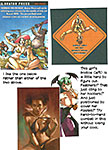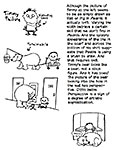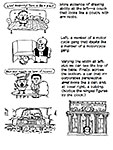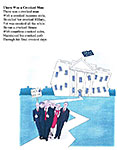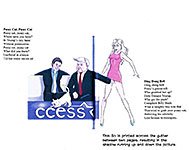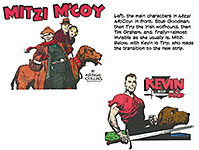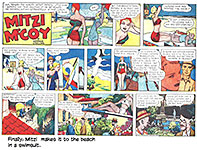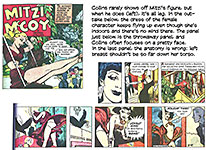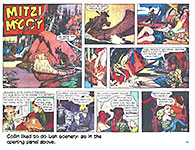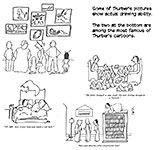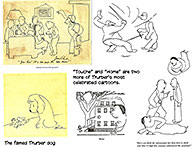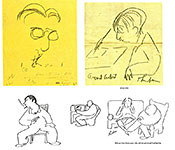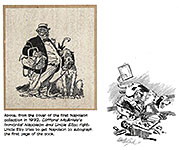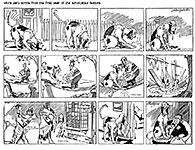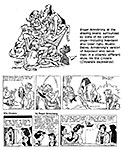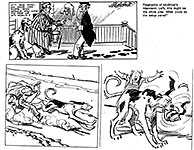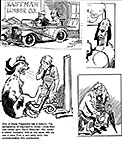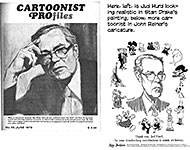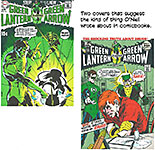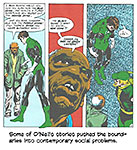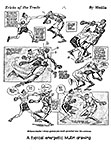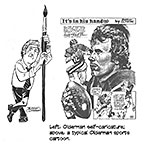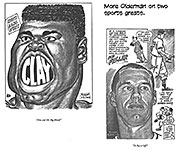 |
|||||||||||||||||||||
Opus 405 (June 29, 2020). To assist you in finding amusements during your sheltering-in-place, we’ve produced another whopper of an opus—lots of editorial cartoons to ponder, and reviews of a tome of reprinted Mitzi McCoy, two Thurber books, plus George Floyd and the birth of a battlecry, winning an Emmy, Pastis drawing ability, Political Correctness reigns, Free Comic Book Summer, Stone Soup ends, Jaffee retires, Nancy Drew’s phony “death” and obits for Dennis O’Neil, Murray Olderman, and Frank Bolle—and more. To help you in wading through all this plethora, we’re listing Opus 405's contents below so you can pick and choose which items you want to spend time on. Here’s what’s here, by department, in order (the longest entries are marked with an asterisk*)—:
NOUS R US Free Comic Book Day All Summer DC Comics Distribution Pandemic Suppresses Free Speech *Lechery and the Penile Prompt: Political Correctness Still Reigns Jaffee Folding It Up Fudd and Sam Go Unarmed Birth of a Battlecry Comics with Anti-Racism and African-American Themes Denver’s Pop Cult Con Cancelled Tanquary Documentary Wins Emmy Open Up the Churches
ODDS & ADDENDA Avatar Comics on Hold Garfield’s Millions
Stone Soup To End The Chronological Life of Stephan “Pearls’ Pastis Department of Shameless Plugs
FUNNYBOOK FAN FARE The Graphic Novel Refuge for Bad Writing The Death of Nancy Drew No.2 of Queen of the Black Coast
TRUMPERIES The Antic Idiocies of the Self-Indulgent Buffoon in Chief
EDITOONERY The Mock in Democracy **A Round-Up of the Last Month’s Political Cartoons
*The State of the State of Editoonery
NEWSPAPER COMICS PAGE VIGIL The Bump and Grind of Daily Stripping
RANCID RAVES GALLERY An Early HarvToon And Other Visual Excitements
BOOK MARQUEE Short Reviews Of—: Timmy Failure by Stephan Pastis Nursery Rhymes for Trumpian Times
BOOK REVIEWS Long Reviews Of—: *The Complete Mitzi McCoy A Mile and a Half of Lines: The Art of James Thurber Thurber: Writings and Drawings
WHAT I LEFT OUT WAS... **Another Magazine I Almost Published
PASSING THROUGH *Dennis O’Neil *Murray Olderman Frank Bolle
**Rozankowski on DC and Diamond
QUOTE OF THE MONTH If Not of A Lifetime “Goddamn it, you’ve got to be kind.”—Kurt Vonnegut
Our Motto: It takes all kinds. Live and let live. Wear glasses if you need ’em. But it’s hard to live by this axiom in the Age of Tea Baggers, so we’ve added another motto: Seven days without comics makes one weak. (You can’t have too many mottos.)
And in the same spirit, here’s—: Chatter matters, so let’s keep talking about comics. AND—
“If we can imagine a better world, then we can make a better world.”
And our customary reminder: don’t forget to activate the “Bathroom Button” by clicking on the “print friendly version” so you can print off a copy of just this installment for reading later, at your leisure while enthroned. Without further adieu, then, here we go—:
NOUS R US Some of All the News That Gives Us Fits “If you steal from one author, it’s plagiarism; if you steal from many, it’s research”—a quip attributed to someone named Mizner. In the course of my reporting here, if I cite a source, chances are I am also appropriating its words verbatim, often without using quote marks. I don’t want to clutter up the otherwise pristine page with too many of those “crooked marks” (as Bernard Shaw dubbed them), but I don’t want to take credit for the brilliance of another writer’s persiflage either. Putting you on notice herewith lightens the burden on my conscience.
FREE COMIC BOOK DAY ALL SUMMER FCBD this year will take place all summer in order to accommodate social-distancing and store capacity regulations across the country. Scheduled to take place between July 15 and September 9, retailers will receive five to six FCBD titles in their weekly shipments during each week of the promotional window. Release of these titles may vary from shop to shop, as retailers are encouraged to release the books as they see fit for their unique circumstances. Retailers may release one free title a day, make all of that week’s free titles available at once, or any other plan that works for them. Free Comic Book Summer is designed to be flexible and customizable so retailers and consumers can get the most out the event. Free Comic Book Summer will feature 45 of the previously announced titles from publishers like Marvel Comics, Image Comics, BOOM! Studios, Dark Horse Comics, IDW Publishing, Dynamite Entertainment, and DC, plus two educational support titles from the Comic Book Legal Defense Fund and Gemstone Publishing. A complete listing of all 45 FCBD titles, including the 10 Gold Sponsor and 35 Silver Sponsor comic books, can be viewed online at www. freecomicbookday. com.
DC COMICS DISTRIBUTION From ICv2 In its continuing move away from Diamond Comic Distributors and into a new era of distribution to comic shops, DC Comics has announced the roster of four distributors it will use for its DC Direct statue, figure, and collectible line. In addition to Lunar Distribution and UCS Comic Distributors, Inc., DC Direct products will also be available to retailers in North America from EE Distribution, the wholesale division of Entertainment Earth, Inc., and Sideshow. Sideshow will also handle all territories outside of North America. (Mile High Comics’ Chuck Rozankowski, in Denver had a lot to say about DC’s decision to divorce itself from Diamond. We’ve posted his say-so and another view at the very end of the scroll if you’re interested in submerging yourself in its archania.)
CORONAVIRUS USED TO SUPPRESS FREE SPEECH Journalist and human rights groups are sounding the alarm and issuing the most dire warnings about cartoonists’ security and freedom since the Charlie Hebdo attack over five years ago. Ostensibly stopping the spread of bad information about the coronavirus, authoritarian governments around the world are suppressing on free speech. Cartoonists Rights Network International has joined with Cartooning for Peace, Cartoon Movement and other free press organizations calling for protections for political cartoonists. Terry Anderson of CRNI wrote: “The global pandemic has resulted in many governments enacting emergency powers that limit free expression, their stated aim being to stop the spread of bad information but their actions generally amounting to a crackdown on dissenting views. A most egregious example is Bangladeshi cartoonist Ahmed Kabir Kishore, arrested among several critics of the country’s response to Covid-19 over a month ago and about whom we have heard little since. Myself and other leaders of free expression orgs wrote to the prime minister earlier this month seeking assurances of his well-being and demanding his release.” He went on: “While there are a number of cartoonists whose recent problems can be directly attributed to the pandemic, more broadly the crisis is exacerbating all the existing problems — authoritarianism, intolerance, isolationism, dwindling opportunities — that have afflicted the media landscape and cartooning community for some time. And very recently another layer of complication has been added with the Black Lives Matter movement and certain governments’ heavy-handed response to it. CRNI was among the extensive list of co-signatories supporting IFEX’s letter to the President of the United States last week, exhorting him to protect journalistic freedoms.” The Association of American Editorial Cartoonists joins with CRNI in supporting these statements, and standing with cartoonists worldwide during this time. We encourage cartoonists, journalists and freedom-loving people to post, share and retweet these alerts far and wide.
LECHERY AND THE PENILE PROMPT “God gave men both a penis and a brain, but unfortunately not enough blood supply to run both at the same time.” —Robin Williams
Political Correctness Still Reigns Mild-mannered wildmen and women are pulling down statues of Confederate generals all over the place. No one seems to know how to stop them. So the statues topple. And it’s not just statues. Live people are being attacked for alleged political improprieties. ● Editoonist Tom Toles has a Hallowe’en party every year, and great quantities of people (many of whom are his friends) attend, dressed as their favorite cartoon character or politician. Two years ago, several Ruth Bader Ginsburgs showed up; ditto Brett Kavanaughs. A middle-aged white woman wore a conservative business suit and a name tag that said, “Hello, My Name is Megyn Kelly.” Her face was almost entirely blackened with makeup. The blackface was intended to ridicule Kelly, then an NBC morning show host, who, just that week, had caused a stir by defending the use of blackface by white people: “When I was a kid, that was okay, as long as you were dressing up as, like, a character.” A small squad of the Politically Correct was not amused. Some confronted the woman, telling her she was offending black people. Some of those people were themselves black. Now, two years after the fact, some of the offended have decided to relive the experience in the midst of protests about George Floyd. One of the black women had verbally assaulted the woman who had worn blackface: “People have been murdered,” she recalled saying. She said she addressed the woman “calmly and politely.” “They lynched people back in the day. There’s a painful history, and you should have some respect for that.” Toles is being held responsible for the behavior of his guests. He should have kicked the blackfaced woman out, say the Politically Correct. He was not innocent in the conflict, said the black woman: “As you well know, we are an extension of the company we keep.” ● Elsewhere, a 14-year-old allegation about sexual impropriety has ended the career of Charles Brownstein as executive director of the Comic Book Legal Defense Fund (CBLDF). He resigned as executive director of the organization, effective June 22. The news comes following a weekend of mounting pressure as the antique allegations against Brownstein resurfaced and creators publicly pulled their support from the organization. The CBLDF has come under much fire for protecting and promoting Brownstein in the more than a decade since the assault allegations came out, reported Joe Grunewald at comicsbeat.com. “Despite Brownstein’s resignation, severe damage has already been done to the CBLDF’s reputation, and it will likely take some time — and perhaps some sweeping changes elsewhere in the organization — to rebuild trust between the organization and the larger comics community.” ● Even more recently, another allegation of misconduct against a high-profile figure in the comics industry has been made. Writer/artist Jason Latour has been accused of harassment by artist and designer Lauren Tracey. The incident reportedly took place at 2017's Thought Bubble Festival. Three years ago! And the “harassment” consisted largely of Latour pestering the woman for a date—or an assignation in his hotel room. He needs to learn better manners. ● Spurred by accounts of the misconduct by artist Cameron Stewart, many women have come forward to accuse writer Warren Ellis of predatory behavior. Well, of “grooming” young women writers. DC Comics has removed a two-page story written by Ellis in Dark Nights: Death Metal - Legends of the Dark Knights one-shot. Ellis issued a statement: "Recent statements have been made about me that need to be addressed. I have never considered myself famous or powerful, to the point where I've made a lot of bad jokes about it for twenty-odd years. It had never really occurred to me that other people didn't see it the same way—that I was not engaging as an equal when gifted with attention, but acting from a position of power and privilege. I did not take that into account in a number of my personal interactions and this was a mistake and I own it. I hurt people deeply. I am ashamed for these mistakes and I am profoundly sorry." His statement continues: “I will not speak against other people's personal truths, and I will not expose them to the toxicity of the current discourse. I should have been more aware, more present, and more respectful of people's feelings and for that I apologise. I have had friendships and relationships end, sometimes in bitterness, often due to my own failings, and I continue to regret and apologise for the pain I have caused. I have always tried to aid and support women in their lives and careers, but I have hurt many people that I had no intention of hurting. I am culpable. I take responsibility for my mistakes. I will do better and for that, I apologise. “I apologise to my friends and collaborators for having created this situation, and I hope they will be treated kindly. Mistakes and poor choices in my personal life are not on them, but only on me. We have a responsibility to one another, every day. And I have, in my past, let too many people down. I hope to one day become worthy of the trust and kindness that was placed in me by colleagues and friends. I will continue to listen, learn, and strive to be a better human being. I have sought to make amends with people, as I have been made aware of my transgressions, and will continue to do so.” His statement is somewhat longer, but what I’ve quoted here suggests the tone and tenor of his apology. Good for him. And, remember, he was not accused of any sexual misconduct. Just “grooming.” The question still remains of what will happen with The Batman's Grave, the twelve-issue series Ellis has been writing with artists Bryan Hitch, Kevin Nowlan, and Alex Sinclair. A new issue of that series is due out on Tuesday, July 7th. Order cut-off for that issue was June 15, so it may be too late to cancel at this point if that's what DC intends to do. Will Ellis lose his career? And so we go on and on, tearing down statues and reputations. Much of it done by allegation rather than evidentiary proof. Of course the women are right to complain of predatory or harassing behavior from men. Of course men ought to behave more politely. But when allegation alone can destroy a man, we ought to stop and think for a moment about what we are doing to our system of justice. The women are not at fault here: it’s the rest of us and how we react.
JAFFEE FOLDING IT UP Mad magazine is celebrating its longest-tenured contributor, Al Jaffee, with an issue devoted to him on the occasion of his retirement, reports George Gene Gustines at nytimes.com. The latest edition of the smart-alecky bible of boomer humor, billed as the “Special All Jaffee Issue” and available Tuesday, June 16, is filled with reprinted and previously unpublished work by or about Jaffee, the creator of two signature features in the magazine, the intricate Mad Fold-In and Snappy Answers to Stupid Questions. “I’m 99 years old — and I stress the old,” Jaffee told Gustines in an interview. “I used to be able to work around the clock and produce a Fold-In or an article, but it is not something I can do anymore.” Jaffee came up with the Fold-In in 1964 as a satirical reversal of the centerfolds in Playboy and other magazines of the era. The final Fold-In, which he created in 2014 in anticipation of his retirement, seems suited to a time when businesses have been disrupted by the coronavirus pandemic. When readers fold the page in thirds, a new message is revealed: “No More New Jaffee Fold-Ins.” And the artist’s serene visage is seen floating above the cityscape. The
first Snappy Answers to Stupid Questions feature, from 1965, also
appears in this commemorative issue. [And hereabouts.] “I had two jobs all my life,” Jaffee said. “One of them was to make a living. The second one was to entertain. I hope to some extent that I succeeded.” Born in 1921, in Savannah, Ga., Jaffee met some of his future Mad co-conspirators in the 1930s, when they were students at the High School of Music and Art in New York. He followed a circuitous path to finding like-minded artists. As young boys, Jaffee and his three brothers were taken by their mother, Mildred Jaffee, to her home city, Zarasai, Lithuania, for what became an extended visit. In 1933, Jaffee’s father brought Al and two of his brothers back to America for good. The family lived in Far Rockaway, N.Y. Mr. Jaffee’s youngest brother did not leave Lithuania until 1940, shortly before much of Zarasai’s Jewish population died in World War II. The losses included Mildred. Although Mad no longer publishes new material as a matter of policy, this issue is different because it has new material—tributes to Jaffee by other Mad artists. The cover, by Sam Viviano, depicts Jasffee as a doctor examining the brain of Alfred E. Neuman (and finding it lacking). A “Spy vs. Spy” installment by Peter Kuper includes a Fold-In that shows Jaffee adding to the chaos of the eternally warring secret agents. Sergio Aragonés provides several interpretations of the 99-year-old artist, including a four-panel biographical strip. A tribute by Tom Richmond shows Jaffee holding a wine glass filled with ink. The accompanying text offers a salute from the Mad staff, which calls itself “the usual gang of idiots” on the magazine’s masthead. “Thanks for making us look Idiotic — and making readers look twice — all these years,” the note says. “Mad wouldn’t be Mad without you.”
FUDD AND SAM TO GO UNARMED By Allen Kim, CNN online Elmer Fudd and Yosemite Sam are sporting different looks in the new "Looney Tunes Cartoons" that launched on the new streaming service HBO Max. While their outfits remain the same, both will no longer be carrying guns. The cartoons will still have plenty of sticks of Acme dynamite and cartoon violence, but Fudd will no longer carry his oversized hunting rifle and Sam won't have his pistols. “We're not doing guns," executive producer and showrunner Peter Browngardt said in an interview with the New York Times. "But we can do cartoony violence,” he went on, “— TNT, the Acme stuff. All that was kind of grandfathered in."
BIRTH OF A BATTLECRY George Floyd has given an equal rights movement a slogan with emotional power because it is real. At Floyd’s funeral, Al Sharpton gave the eulogy in which he said: “Ever since 400 years ago, the reason we could never be who we wanted and dreamed of being is that you kept your knee on our neck. ... We were smarter than the underfunded schools you put us in, but you had your knee on our neck. We could run corporations and not hustle in the streets, but you had your knee on our neck. We had creative skills; we could do whatever anybody else could do, but we couldn’t get your knee off our neck. “It’s time to stand up and say, ‘Get your knee off our necks.’”
COMICS WITH ANTI-RACISM AND AFRICAN-AMERICAN THEMES A List from the Comic Book Legal Defense Fund “As the demonstrations occurring across the country prove, free expression makes an important difference in affecting positive social change.” CBLDF has created a reading list of comics addressing themes of anti-racism and the African American experience as a starting point to help parents and educators continue the important discussions in the days and weeks ahead. “We also highlight resources from CBLDF to help frame teaching opportunities in the classroom and beyond.” Visit the CBLDF website to see the list. CBLDF reminds us that fiction is not a deadend or a blind alley. “Fiction is the first draft of policy — these graphic novels are helpful for creating understanding and visualizing solutions. Use them to start discussions, and encourage students to make their own stories in response that articulate what a more just, equitable, and moral world looks like. If we can imagine a better world, then we can make a better world.”
DENVER’S POP CULTURE CON CANCELS NOVEMBER DATES In cancelling its July 4 plans for 2020, the Pop Culture Con opted instead to convene over Thanksgiving but recently found it could not meet then because the State of Colorado announced its intention of extending its use of the Colorado Convention Center for hospital beds through the end of the year. Denver Pop Culture Con will return in 2021 on May 14-16. All tickets for the cancelled Con will be refunded; 2020 exhibitors have options for refunds or 2021 credit. The Denver Con contributes $10 million – $40 million in economic benefit to downtown Denver annually. It also offers a major market for creators and a variety of opportunities for on-site education and entertainment. Hundreds of students and educators who might otherwise be unable to attend are able to enjoy Denver Pop Cult Con through scholarship programs. Proceeds from Con support year-round efforts by Pop Culture Classroom to educate and connect people through the pop culture they love, including free comics, video classes, workshops, and more. Said Denver Pop Culture Con Director Christina Angel: “We’re profoundly disappointed that we won’t be able to hold Denver Pop Culture Con this year, but the health and safety of our community is our highest priority. We are committed to doing as much as we can to reduce frustration and inconvenience as everyone deals with this unprecedented situation. And in the meantime, we’ll get to work on creating a fantastic event for 2021. “Denver Pop Culture Con isn’t just about fandom,” she added. “It’s a place where we come together and celebrate that which we love. It’s like a family reunion.”
TANQUARY DOCUMENTARY WINS EMMY The nominations for the 72nd Los Angeles Area Emmy Awards where announced on June 8th. These Emmys are given to Los Angeles television stations and cable television for broadcast achievements for Local News, Programming, and Sports within the Los Angeles market. The independent documentary “Hand Drawn Life” was aired on local PBS station KCET during the qualifying year of 2019. It was submitted in the Independent Programming category. As no other entry in that category was deemed worthy of nomination, “Hand Drawn Life” has already been awarded the Emmy. The official LA Emmy event to reveal the winners in other competitive categories isn't until July 18th. “Hand Drawn Life” is the film Tom Tanquary has been working on for a decade or more. The film traces the history and influence of American newspaper comic strips, an art form, arguably the first example of American pop culture, that has been greatly under-appreciated. Told through the voices of almost two dozen cartoonists and comics historians, it looks at the many ways these small, haiku-like creations have influenced and reflected American society. From being stuck to refrigerator doors or hidden in pages of a diary, they have been an medium of emotional expression and comfort for generations. Their story is the story of American culture. Somewhere along the way, R.C. Harvey joined Tanquary—at Tanquary’s invitation. Said Harvey: “My job was to interview cartoonists about how life was achieved by drawing it. While I conducted the conversations, Tom filmed them all. And then, later, he picked the parts that he would knit together to tell the story. So Tom is the one who won the Emmy. I am a winner only because I hitch-hiked onto his project. And because the byline says by Tom Tanquary with R.C. Harvey; I don’t think I get a trophy for the shelf on the wall.” You can see a smatttering of the film at https://www. youtube.com/ watch?v =SOfYCkC9ccg AND MORE WORDS AT—: http://www.handdrawnlife.com/home.html
OPEN UP THE CHURCHES And Infect Trumpet Supporters The Trumpet and thousands of others want churches to be open again. Trump advocates opening the churches because that stance will appeal to his base, which includes a few hundred thousand Evangelical religionists who will applaud his religious fervor (and vote for him come November). But churches are probably the most dangerous of environments during a pandemic like this. Judy Stone at Forbes.com says: “Gathering crowds in confined spaces is ‘a great way to spread Covid-19,’ and if you add singing to the mix—‘an activity that expels virus-filled droplets from the mouth with greater velocity and range than regular speech or breathing’—the deadly effect is magnified.” Opening up churches is not a good idea. Not yet. Trump’s stance is motivated by pure politics, reported the Washington Post, “—not any genuine concern for ‘religious liberty.’ He and his aides panicked at a poll that showed a double-digit drop in his favorability with white Christians,” one of his loyal cults. And it could all backfire. If Trump cultists go back to church, lots of them will get sick, and some will die. And the Trumpet will thereby lose votes.
ODDS & ADDENDA Avatar Comics, which also publishes the sex-saturated adult Boundless line, has gone on hold for the summer. “The current fluid retail situation is one we can best serve by pausing.” Ditto Boundless. From the comic strip and merchandise, movies, television specials and shows, the fictional cat Garfield is a multimillion-dollar and maybe even a billion-dollar character. The classic character is so beloved, Licensing International reported that Garfield merchandise makes $750 million to $1 billion in annual sales.
Fascinating Footnit. Much of the news retailed in the foregoing segment is culled from articles indexed at https://www.facebook.com/comicsresearchbibliography/, and eventually compiled into the Comics Research Bibliography, by Michael Rhode, who covers comic books, comic strips, animation, caricature, cartoons, bandes dessinees and related topics. It also provides links to numerous other sites that delve deeply into cartooning topics. For even more comics news, consult these three other sites: Mark Evanier’s povonline.com, Alan Gardner’s DailyCartoonist.com (now operated without Gardner by AndrewsMcMeel, D.D. Degg, editor); and Michael Cavna at voices.washingtonpost.com./comic-riffs . For delving into the history of our beloved medium, you can’t go wrong by visiting Allan Holtz’s strippersguide.blogspot.com, where Allan regularly posts rare findings from his forays into the vast reaches of newspaper microfilm files hither and yon.
ONWARD We need to get used to it. This pandemic stuff will go on for years. Given the absence of leadership at the White House, the kind of testing that health experts advocate is not likely to happen soon. And remember: we all need to be tested at least once every two weeks. That’s a monumental number of tests. Probably won’t happen. And so we’ll be wearing masks and social distancing for years. It’s the new normal.
STONE SOUP TO END Jan Eliot, creator of Stone Soup, announced, rather unconventionally, her retirement. The rest of this report is from her. For
those of you who saw this Sunday’s strip [June 21], I know you can see that I
have decided to retire Stone Soup. I can’t imagine turning the strip,
which is so personal to me, over to anyone else, and my syndicate is not
planning on reruns. The last Stone Soup strip will appear on July 26,
when I will officially jump off the funny pages. Years ago, when I was still an aspiring cartoonist, I photocopied one of my strips, reducing it to the size of the other cartoons on the funnies page, and pasted it there as a way to visualize my someday success. I have always felt so fortunate to be part of this amazing world, to have such a wonderful, enjoyable career. It will be as strange for me to see the funnies pages without Stone Soup as it will be for you. But... after a late start (I was 45 when it finally got syndicated) my 25 wonderful years in cartooning have brought me to a very “wise” age, and I am ready to be completely free of deadlines, obligations, and schedules. As many of you know I love to travel and if Covid-19 ever gets beaten back, I intend to do quite a bit more. I have family and friends all over the world, a wonderful group of cartoon friends in South Africa, and a bizarre love of long-haul plane flights. Look out world, here I come! I hope I can find a way to tell you all how much I appreciate you. Your support and love of my work, my characters, and my perspective has been a huge gift. Thank you. Thank you for the privilege of entertaining you. Thank you for the love. Thank you for everything! Stay safe. Wear a mask. Be kind.
Footnit from St. Wikipedia—: Before becoming a full-time cartoonist, Eliot worked as a waitress, car salesperson, bookmobile driver, advertising copywriter, graphic designer, and greeting card writer. In her cartoonist career, she initially worked as a graphic designer in the daytime, while doing cartoons at night. Some independent papers published her work, and after 16 years, she achieved syndication, and became a full-time cartoonist. Prior to Eliot's syndication, she was mentored by cartoonist Lynn Johnston, who proofed the cartoon strips. She chose the name Eliot after her divorce, in honor of a British woman writer, Mary Ann Evans who used the pen name George Eliot in producing several novels. Jan Eliot lives in Eugene, Oregon and is married to Ted Lay. Before Stone Soup, Eliot created another strip, Patience and Sarah, which enjoyed a run of five years in ten publications. Her next comic strip was called Sister City. This weekly strip appeared in the Eugene, Oregon newspaper, Register-Guard for five years before the name was changed to Stone Soup in November 1995, when it became nationally syndicated by Universal Press Syndicate/Universal Uclick. Stone Soup is syndicated to more than 300 newspapers, mostly in America but also across the world.
FURTHER ADO The Chronological Life of Stephan “Pearls” Pastis Jan. 16, 1968 Born in Los Angeles
1989 Graduates UC Berkley with a degree in political science.
1990 Begins law school at UCLA.
1993 Begins working as an insurance defense litigation attorney in the Bay Area.
Mid 1990s Submits several comic strip ideas to syndicates.
1996 Meets Peanuts creator Charles Schulz and solicits advice on comic strip creation.
1999 Pastis submits strips to more syndicates.
2000 Universal syndicate gives Pastis a six-month online tryout. Interest picks up after Dilbert creator Scott Adams endorses Pastis’ work.
Jan. 7, 2002 Pearls Before Swine debuts in 150 papers. Pastis quits his law job.
Sept. 1, 2004 First Pearls treasury, collecting 18 months of strips, is published. Pastis will publish 10 more over next 16 years.
2011 Co-writes Peanuts tv special, “Happiness is a Warm Blanket, Charlie Brown.”
Feb 26, 2013 Publishes first of nine Timmy Failure children’s books
May 20, 2019 Wins Reuben Award: Cartoonist of the Year from the National Cartoonists Society Feb. 7, 2020 Timmy Failure movie, “Mistakes Were Made,” begins streaming on Disney+.
P.S. By the time Pastis was born, I’d already graduated from college, served almost four years in the Navy, and taught school for four years. And now, as of this month, I’m 83.—RCH
DEPARTMENT OF SHAMELESS PLUGS Somewhere online, Michael Dooley, creative director of his own design business and Print Magazine contributing editor and author, talks about his profusely illustrated Print Magazine feature story on E. Simms Campbell, the legendary black cartoonist at Esquire (and elsewhere) and mentions his interview with me. If you’re interested, go to https:// www.printmag .com , and once you’re there, scroll down to “Insider Histories: Black Cartoonist E. Simms Campbell.” After a liberally illustrated article on Campbell comes Dooley’s interview with me that he conducted some years ago. It’s all still applicable. Some of it is about black cartoonists; some of it is about other aspects of cartooning—my list of the top ten cartoonists, f’instance. A lot of my Campbell discoursing repeats what you can find in my latest book, Insider Histories of Cartooning: Rediscovering Forgotten Famous Comics and Their Creators, which is offered for sale at this very website.
FUNNYBOOK FAN FARE Four-color Frolics THE GRAPHIC NOVEL has turned out to be a boon for biographers who are not very good writers. Instead of writing a respectable book of prose, they collaborate with an artist to produce what they call a graphic novel. Unhappily, the graphic novels produced under this scheme are not very good graphic novels. That’s because the so-called “writer” doesn’t understand the verbal-visual medium. In effect, he/she doesn’t trust the narrative strengths of pictures. Many of these efforts make almost no use of the resources of the form: instead of blending pictures and words to tell their stories, the narratives of these books are carried by words. This kind of writer’s narrative consists of verbal captions for the artist’s pictures that usually tell us what the picture is depicting instead of adding to that depiction some fresh crumb of the story. Or, during the less picturesque parts of the biography, the pictures merely decorate the pages while the writer’s captions drone on, rehearsing the story. When the biography says the subject went to school in St. Louis, the picture over that caption is of the St. Louis Arch, contributing absolutely nothing to the narrative. And because there are more bad writers than bad artists, the market is becoming awash with these graphic novelesque biographies. I suspect that many biographies that assume the guise of graphic novel do so merely to hitch the writer’s hobby horse—the subject of the biography— to a popular “new” genre in hopes of finding a publisher eager to make sales in bookstores. But because most biographies include stretches of a person’s life that are not very picturesque, many of the book’s pages are inert and dull. The most recent Previews offers at least two more of these disasters—biographies of Leonardo da Vinci and another of Rodin. I haven’t seen either, but I’m betting these are both essentially abbreviated verbal narratives accompanied by pictorial decorations. Not graphic novels. People who want to know what a successful graphic-novel style biography looks like should consult Rancid Raves Opus 402 and our review of the biography of Josephine Baker.
An admirable first issue must, above all else, contain such matter as will compel a reader to buy the second issue. At the same time, while provoking curiosity through mysteriousness, a good first issue must avoid being so mysterious as to be cryptic or incomprehensible. And, thirdly, it should introduce the title’s principals, preferably in a way that makes us care about them. Fourth, a first issue should include a complete “episode”—that is, something should happen, a crisis of some kind, which is resolved by the end of the issue, without, at the same time, detracting from the cliffhanger aspect of the effort that will compel us to buy the next issue. A completed episode displays decisive action or attitude, telling us that the book’s creators can manage their medium.
THE PUBLICITY about Nancy Drew and the Hardy Boys: The Death of Nancy Drew has been insistent enough that no one, let alone moi, could avoid buying the first issue, written by Anthony Del Col and drawn by Joe Eisma. As a first issue, it contains all the criteria I look for—suspense, mystery, and a tantalizing ending. The entire issue is narrated by Joe Hardy who claims to love Nancy, and that, plus a healthy dose of skepticism prompts him to investigate her death. She died in an auto accident, and when Joe rushes to the scene of the accident, he says he saw her remains being fished out of the water into which she’d plunged her car. Despite the assurances of the police that no foul play was involved, Joe thinks she was murdered. The rest of the issue shows him methodically exploring every avenue to find her murderer. In a couple of completed episodes, he quarrels with his older brother Frank, who tells him repeatedly that he’s wrong about Nancy’s being murdered. These episodes show Joe to be a little less than reasonable. I’m not sure I like him all that much, but he keeps insisting that Nancy was killed, and his doggedness is admirable. And then on the last page of this issue—here’s Nancy, saying: “What are you doing, Joe? You’re gonna ruin everything.” And I think that’s Frank lurking in the background. If he’s in on Nancy’s ploy, that explains why he kept insisting to Joe that Joe “move on” and give up his one-man inquiry. So the whole thing—the advance publicity, the death of Nancy Drew and the suspicion that she met foul play—all of that evaporates with the turn of a page. We’ve been snookered.
At one point, Carson Drew, Nancy’s father, is supposed to have reached a plea deal to avoid jail time; but a page or so earlier, Carson Drew’s problem is a “near death” situation. So, which? And facing the last narrative page with Nancy Drew in full view is a come-on for the next issue: “Is Nancy Drew really dead? Is she still alive?” No, she’s not dead, and she’s still alive: she’s standing right there, in front of us.
THE SECOND ISSUE of The Cimmerian: Queen of the Black Coast which brings Conan and the scrumptiously nearly naked Belit together is, alas, a disappointment. It’s a disappointment because Belit gets killed, effectively ending the series. On their expedition upriver, she and Conan discover a huge trove of gold, but Conan sees that their ship is under attack and must leave to defend it. Belit undertakes to transport the gold to their ship. Conan goes off, also looking for fresh water because the river they came in on is too contaminated to drink. On his quest, he runs into a winged monkey monster and kills it. Then when he returns to the ship, he sees that the monkey monster demons have attacked, killed all the crew—and the sumptuous Belit, leaving her hanging from the yardarm. Conan goes on a vengeful spree, killing another monkey monster or two. The end. Sorry, but that’s all we have of Pierre Alary’s exquisite artistry. The story seems a little confused: pages of Conan killing monkey monsters, and I’m not sure which of his quests are being depicted. But that doesn’t matter. It’s Alary’s pictures that make this book, and to preserve them for another loving reading, I’ll save both issues. And for your entertainment, I’m posting the cover of No.2—by Chriscross —and a couple of Alary’s inventive pages.
QUOTES & MOTS Who Was That Masked Man? For anyone who views the prevailing international order as a brutish contest for resources, disguised occasionally by noble words and fine treaties, the scramble for masks this spring offers a perfect little parable. It has taken on the appearance of a zero-sum struggle straight out of a game-theory seminar: with limited supply and endless demand, one mask for you is one mask less for me. To this austere truth, nations have reacted in familiar ways. ... The U.S. has treated the procurement of masks as a smash-and-grab operation. In April, French officials accused Americans of indulging each on the runway of a Shanghair airport, buying up a cargo of masks that was already on a plane, ready to fly out to France. [In another case, an agent reported that his cargo was ready,] and then some Americans showed up, paid three times the price, and bought his order out from under his nose.
TRUMPERIES The Antic Idiocies of the Self-promoting Buffoon in Chief THE TRUMPET DOESN’T WANT to give the hard-up financially-devastated Postal Service any money to operate on because he believes that it gives Amazon a discount on its shipments. It doesn’t. But that doesn’t matter to the Trumpet, who lives in his own private delusional world. And what does Trump have against Amazon? It’s owned by Jeff Bezos, who also owns the Washington Post, which is highly critical of Trump. You follow that? So the Prez of the U.S. is prepared to destroy the Constitutionally mandated Postal Service in order to get back at the Washington Post. Well, that’s the Trumpet for you.
ONCE AGAIN, we assemble a brief but heart-felt tribute to the world’s biggest asshole. Clearly, he not only started out as an asshole, but he went to school to learn to be an even better asshole. And then he got an advanced degree in it. Tom
Toles gets us started with the image of a wall-sized portrait of Trump as
the Cult of Personality: it’s “personavirus” time, an allusion to the pandemic
that has all but destroyed the Trumpet’s dream for an uninterrupted vault into
a second term. Next, Mike Smith deploys 4 panels to mark the milestones on Trump’s road to greatness. Once Trump realizes the signs are all pointing down, he immediately blames his predecessor for everything that’s happened. No joke: this is fact. Clay Jones is back with a couple of wishful birds. I suppose that they are looking forward to the day when they can shit on Trump’s statue. If that’s not what they’re thinking, what else? Our
next visual aid begins with John Darkow’s reminder that the Trumpet has
been seeking for years to shut down Obama’s DACA. But the Supreme Court has
shut him down for the time being. Nick Anderson’s image shows us how the Trumpet manages to exacerbate any crisis with a few words from the White House. Well, it’s not a few words: it’s a flame thrower, and it sets everyone afire. Finally, Rob Rogers returns with a Memorial Day remembrance of when the U.S. was a global leader. Hint: it was before the Trumpet started setting up gravestones to mark what wonders had once been. That’s enough for laughs. Now, onward to the Serious Stuff.
EDITOONERY The Mock in Democracy THE
TRUMPET gets himself lots of headlines in newspapers: virtually every day, he
does or says something colossally stupid and arrogantly monarchial, and the
headlines burst forth. Ruben Bolling celebrates some of Trump’s recent
rowzers in the accompanying Tom the Dancing Bug episode in which Bolling
categorizes and labels various Trump utterances—“Slapstick,” “Burlesque,” etc. Said editoonist Michael de Adder for Counterpoint: “Trump’s Tulsa Rally was nothing but a giant dog whistle. It illustrated that Trump will stoop at nothing to win a second term as President. Although a disaster with attendees, sabotaged by teens on TikTok, Tulsa was a record setter for ratings for Fox News. Proving that his message of hate does resonate with too many Americans.” Then we have Kevin “Kal” Kalaugher, whose imagery springs from the newsstory that Trump looked like he was losing his footing as he descended a ramp after making a speech. In Kal’s hands, Trump himself descends in size, by which Kal may mean Trump’s power is diminishing. Kal then added a paragraph of prose on the subject: “Donald Trump’s recent Tulsa rally hit a new low—not just in its lackluster attendance but also the blathering baloney emanating from the pillock at the pulpit. There was no grand campaign strategy or inspiring message for the future, only rambling childish histrionics. We may have become accustomed to these pathetic ego-boosting spectacles, but Trump’s embarrassing antics at these rallies continues to diminish himself, his party and our nation.” More
Trumpest headlines inspire the next couple editoons. Steve Breen uses a visual metaphor of a mileage-like gauge to present a sobering view of the Covid-19 circumstance as the number of deaths in the U.S. passes the 100,000 mark. At the lower left, Rob Rogers’s imagery superimposes a picture of the Trumpet golfing over a newspaper front page that reports on the 100,000 mark. The contrast of factual reality in the newspaper headline with the defiant responsibility-free Prez playing golf is a grim comment on the Trumpet’s failure to recognize reality when he encounters it. Meanwhile,
Covid-19 continues to rage even as many states are lifting restrictions in an
effort to return us to normalcy. Immediately below Horsey, Rick McKee conjures up a picture of one of the many varieties of crazy—the anti-vaccine proponent, who sees any movement toward vaccine-treatment for an authentic disease as another kind of conspiracy, one that will undermine the anti-vaxxer’s belief. Tom Toles’ image of a freely breathing Earth reminds us that when whole populations stay at home, the atmosphere gets relief from the constant infusion of methane and other toxic gases that are the by-product of gasoline-burning vehicular traffic.
IN
THE MIDST OF THE PANDEMIC we have a new manifestation of the racism that lurks
in the American pysche. The image coupled to the words—“taking a knee in America”— have created a fresh symbol of racism in the U.S., one that thousands of marchers across the country evoked with their protest in the streets. It was for eight minutes and 46 seconds a living symbol. But George Floyd was dying. And we watched him. On scores of video replays, we watched George Floyd die with officer Derek Chauvin kneeling on his neck, cutting off oxygen. We hadn’t seen many other black deaths on camera. We hadn’t seen Jamar Clark die. We hadn’t seen Philando Castile die. We hadn’t seen Breonna Taylor die. We hadn’t seen Justine Damond die. We hadn’t seen the deaths of those whose names Time listed on the red border of its cover. For the first time in the magazine’s history, the cover’s red border carries information—in this case, names, the names of 35 black men and women whose deaths, in many cases by police, were the result of systemic racism and helped fuel the rise of the Black Lives Matter movement. Their names are merely a fraction of the many more who have lost their lives because of the racist violence that has been part of this nation from its start. Their
names are Trayvon Martin • Yvette Smith • Eric Garner • Michael Brown • Laquan
McDonald • Tanisha Anderson • Akai Gurley • Tamir Rice • Jerame Reid • Natasha
McKenna • Eric Harris • Walter Scott • Freddie Gray • William Chapman • Sandra
Bland • Darrius Stewart • Samuel DuBose • Janet Wilson • Calin Roquemore •
Alton Sterling • Philando Castile • Joseph Mann • Terence Crutcher • Chad
Robertson • Jordan Edwards • Aaron Bailey • Stephon Clark • Danny Ray Thomas •
Antwon Rose • Botham Jean • Atatiana Jefferson • Michael Dean • Ahmaud Arbery •
Breonna Taylor • and George Floyd. But we saw George Floyd die. And Al Sharpton taught us the words to the picture. “Get your knee off our necks!” George Floyd was a big man, six-foot six-inches and burly. The sort of man whose mere presence would give a policeman pause. The sort of man that seemed to demand forcible restraint. But we don’t know what George Floyd did that required restraint, that required Derek Chauvin to kneel on his neck and squeeze the life out of him. George Floyd was a gentle man, we learned. So what had he done? Those of us with reasonably good hearing heard his last words. We heard him say, “I can’t breathe.” We heard him cry “Mama”—calling on the person he knew, he was positive, would come to his aid. “Mama.” His deceased mother. For Alicia Smith, a black Minneapolis community activist, hearing George Floyd cry “Mama” with his final breaths brought her to her knees. “You see the video,” she recalled in People magazine, “and you see an adult man that could be your father, your uncle, your brother.” Smith is the mother of two boys, ages 11 and 7. “What I saw,” she goes on, “was my son. What I heard when I saw him scream out and call for his mother, I heard my son calling my name and begging for help. That sound, as a mother, ran so true to me.”
DAVID
FITZSIMMONS repeats the image of a white man kneeling on a black man’s neck to
trace “the knee in America” across the And then we began to see George Floyd’s face—on the covers of magazines, painted giant-size on walls. Everywhere we looked for a short while, we saw his face. It is a strong face. A strong African face with thick lips and broad nose. And a high forehead. A strong face that can stand for African American strengths.
BACK TO OUR PREVIOUS VISUAL AID for a moment, we find Adam Zyglis who turns our attention to another matter, the aversion to mask-wearing. Zyglis converts that into a statement about everyday fear among black Americans, putting a “period” to the other statements about race in America. Organized
objection to wearing a mask is the topic that gets us started in the next
exhibit. Jeff Stahler’s visual comment on the movement to remove statues of Confederate generals highlights the dilemma: removing the statue doesn’t remove the problem that the statue represents. Admittedly, taking the statues down removes a constant irritant among black Americans. But we should also address the root problem. Next, Dave Granlund gets at another problematic aspect of the “cancel culture” movement. If statues of Confederate generals who went to war to preserve slavery must be removed, what about statues of George Washington and Thomas Jefferson, both of whom owned slaves? Is Mount Rushmore doomed? Well, no. The two situations aren’t the same. The Confederates deliberately, consciously, went to war against their own country, killing thousands to support an immoral social order. Washington and Jefferson merely acquiesced, unconsciously, to society’s norms as they existed in their time. We must recognize the distinction between the two or we will indeed “cancel culture.” And then Scott Stantis provides an image of Justice (I assume that’s Lady Justice climbing the ladder) replacing, one moretime, the “equal” qualification for “justice under law.” It’s a shame this labor must be performed over and over again; but we should be thankful that it is done, over and over again—until we get it right. Police
brutality is the topic in our next array. At the upper left, Eric Allie musters
the image of the killing of George Floyd Then Walt Handelsman’s image of hands raised with phones capable of videotaping misbehavior gives raised hands the power to create police accountability.
THE
TRUMPET’S BIBLICAL ADVENTURE did not escape notice by editoonists. Monte
Wolverton offers an image of the Trumpet crossing the street to Lafayette
Square on his way to the church where he’ll create a photo op for Evangelical
voters. Before that peaceful portrait could be made, however, the Prez had to
clear away the mob, the peaceful protesters, which he did by deploying heavily
armed police. Michael de Adder’s image takes us elsewhere, as he explains: “When Donald Trump held up that Bible, I knew it would become the defining moment of the day—or maybe even one of the defining moments of the year. I just looked at his head, the way he was standing… and The Exorcist popped into my head. Trump does that to me.” Trump was widely supposed to have held the Bible upside-down; but that was just wishful thinking by his opponents, who delight in pointing out Trump’s mistakes. He actually held it rightside up. And then at the lower left, Randall Enos uses two pictures to show us that the Trumpet isn’t at all religious, photo ops to the contrary notwithstanding. And his pictures give “double cross” a double meaning. As
the street protests in George Floyd’s name spread across the nation, the
Trumpet, as always, made law-and-order declarations, tough talk about
dominating the streets, which only inflamed the protesters to commit greater
breaches of decorum—a Trumpian activity that Dave Granlund accurately
portrays at the upper left of our next visual aid. Next, Tom Tomorrow (Dan Perkins) supplies another Modern World comic strip in which Trump says what he means for six panels, piling up for a picture of him as a complete buffoon who scarcely knows anything about whatever he’s talking about. The most accurate thing he’s said lately is that the more testing for coronavirus we do, the more coronavirus we find. If we’d just stop testing for it altogether, we’d have no coronavirus at all. Brilliant. Does he think before he opens his maw? Nate Beeler finishes off this exhibit with a picture of Trump kneeling on Uncle Sam’s neck in that now-familiar George Floyd image while a masked hysteric labeled “Antifa” beats the old man with a board. In Trump’s view, the nation-wide protests are the work of the anti-fascists, not good Americans, who wouldn’t think of rioting. But in taking that position, Trump simply fans the flames of the protests by being wrong. The antifa is a minute part of the protest, but by blaming them for the so-called rioting, Trump enables the real provocateurs to do their disruptive work. As a footnote, vaguely related, Beeler says: “There is nothing funny about what’s happening in America. Our country is being brutalized by a man in the White House who has no sense of morality, empathy, or restraint. Antifa, very much like Trump, is doing the same. Members of that group, and other radical activists, are co-opting legitimate grievances for their own violent purposes, perverting them, warping public perceptions. It’s utterly shameful. The blatant evil on display takes my breath away.”
Next around the clock, Pat Bagley creates a monument to the Trumpet—namely, the corruption he represents by acting only in his own best interests. Then Kirk Walters pokes fun at Trump’s insistence on making sure the citizenry knows who to thank for the stimulus checks they received. And cartoonist Sale takes up the same topic at the lower left. That’s Trump’s signature on the Covid-19 ball; and that’s a mask Trump is wearing on his head. To protect it?
WE
LAUNCH into Miscellaneous with the next visual aid. Tom Toles shows
Trump eager to re-open daily life and start the economy again but the country
as a whole isn’t so sure: restarting everything may endanger the lives of
thousands if Covid-19 is still rampant. But the Trumpet needs a resurgent
economy in order to support his claim to re-election. Joe Heller’s visual
metaphor vividly shows where government stimulus money is going: the big loans
life saver seems constructed specifically to miss small business. Matt Wuerker turns his attention to Trump’s new creation, the Space Force—a tough-talk sounding new branch of the military that in Wuerker’s view is just another venue for the military industrial complex to make money out of. Then Clay Bennett’s visual metaphor for a Trump Rally suggests the likely outcome: by collecting large groups of people indoors where the air circulation isn’t that good, the Trump campaign may result in hundreds more people infected with Covid-19. That promising rally venue becomes a coffin. The
forthcoming Election is our focus in the next display. The Republican Party
often describes itself as the Party of Lincoln, and here, Mike Peters shows
us what the Republican Party has become as the Party of Trump, wearing a KKK
hood. Michael de Adder offers another visual metaphor for the Party
Trump, a blunt if vulgar image. Then Nick Anderson assembles that picturesque cast of idiots he’s been using as an image of Trump’s passionate devotees, who’ve become his appointees as inspectors general. Their unreasoning (idiotic) devotion to the Trumpet will surely prevent them from overseeing his operation as inspectors general are supposed to do, so he is effectively free to be as corrupt as he wants to be. The presidential campaign is underway for R.J. Matson, who, at the lower left, shows billboards advertising the Trumpet for Prez. The syntactic logic of the language is that what we lost in 2016 we’re likely to lose again in 2020 if we choose the Trumpet. I
can’t make out a signature in the first cartoon in our next array, but it’s
clear that whoever drew the picture doesn’t find justice on the desk of
Attorney General William Barr—instead, obstruction of justice and miscarriage
of justice are all we can see there. John Bolton and his book are the next two targets. Ed Wefler shows Bolton arriving on the scene too late: the building has already burned to the ground, but Bolton has cashed in—and will even more, once his book is actually in the hands of readers. Then Chip Bok offers in two panels the reason for Bolton’s failure to testify at Trump’s impeachment trial. We all knew that. Dave Horsey finishes this display with a visual metaphor of the American landscape without daily newspapers. Not only is it barren, but with only social media as a source of information, it’s deadly. Our
last exhibit begins with Rick McKee’s visual metaphor depicting an
encounter between Covid-19 (in the guise of Death) meeting a guy who doesn’t
want to wear a mask. McKee’s fat guy is not defiant about not wearing his mask. Other mask-less persons in real life these days are aggressively defiant: “You can’t make me wear a mask! I’m an American citizen and I’m free to do whatever I want, and I don’t want to wear a mask!” Thanks to the Trumpet’s refusal to wear a mask, the mask has become an ideological symbol. Trumpetiers don’t wear masks as a matter of principle: they refuse to give up their freedom. Those who wear masks are intimidated weenies. Next around the clock, John Cole characterizes the present state of the presidential campaign as a boxing match in which Joe Biden sits comfortably in his corner and watches the Trumpet beat himself up —with a succession of bad choices and antagonistic comments that portray him as an unfeeling bigoted bully. John Darkow at the lower right offers a baseball metaphor for the state of professional sports, which is intimidated by a giant, looming Covid-19. The stands are empty, and the guy at bat is a puny fellow. Abraham Madkour, publisher and executive editor of Sports Business Journal, says: “I don’t see any timeline where athletic events have fans packing the stands.” He believes that baseball, hockey and the NBA may play to empty arenas at least into 2021. And if football is played before fans, we’re likely to see 25-30 percent capacities, higher ticket prices, segmented arrival times and cordoned-off sections to give cautious attendees the luxury of distance. “Nobody’s excited about behing around 75,000 people right now,” he says. We finish at the lower left with Chip Bok’s visual metaphor for the “cancel culture” movement, which has the destructive effect of a tornado on our culture’s history, law, art and speech. Denver, from whence this picayune prose emanates, is experiencing some cancellation lately. A Civil War statue, which, oddly, honored Union soldiers, not Confederates, was torn down, and a statue of Christopher Columbus met a similar fate a day later. City officials took down a statue of Kit Carson before protesters could get to it. A frontiersman who epitomized Western expansion in the mid-1800s, Carson waged war on the Navajo Indians and forced nearly 8,000 Navajo men, women and children to take what became known as the “Long Walk” of 300 miles from Arizona to Fort Sumner, New Mexico, where they remained in disease-ridden confinement for four years. And that qualified Carson for cancellation. The director of cultural affairs for Denver Arts & Venues, Tariana Navas-Nieves, said: “We recognized that there are certain pieces such as [the Carson statue] very much tied to a history of genocide and colonial oppression. For us, [removing the statue] is the right thing to do. “The goal,” she continued, “is not just to look at right now ... but really to create legacy and prophecy. When we are gone, when there are public processes in terms of naming buildings ans streets, that there is process in place that is inclusive and diverse and addresses any type of racism and social injustice. “We need to have accurate portrayal of our history to build stronger relationships with communities,” she finished. Noble goals, no question. But if we tear down statues and obliterate all public spaces references to our often unhappy racist history, future generations are likely to think our history is as pure as the driven snow—no racism, no bigotry. Just happily dancing populations weaving across the landscape. How accurate a portrayal of our history is that? What sort of legacy is that? Instead of tearing down statues that remind us of our unfortunate history, we ought to be putting up new statues that commemorate our improvements and advances—and our aspirations, our hopes. Together, the old statues and the new will tell our history. Now that is a legacy that is an accurate portrayal of our history.
**** ANNUAL STATE OF THE STATE OF EDITOONING ADDRESS* By David Fitzsimmons, Arizona Daily Star Editoonist During the second World War, British cartoonist David Low was despised by Hitler because he relentlessly refuted the lies broadcast by the Nazi propaganda machine with every stark cartoon. We’re a long way from the age in which internationally applauded cartoonists such as Sir David Low were knighted for their heroic defense of liberty. When I opened my annual trade journal, the American Association of Editorial Cartoonists Notebook, the bell tolled for my profession, page by page, cartoonist by cartoonist. This year our annual AAEC convention will convene in Ottawa, Ontario, with our Canadian colleagues because our numbers are so small we could meet in an abandoned Fotomat kiosk. [The AAEC convention has been cancelled/postponed due to the coronavirus pandemic.] Political cartoonist Bruce Plante called me from Oklahoma when his paper, the Tulsa World, had just been acquired by Lee Enterprises [which owns the Arizona Daily Star, Fitz’s paper]. He was needing reassurance so I told him, “Lee values cartoonists.” When we began our careers four decades ago there were hundreds of us. Today there are 25 newspaper editorial cartoonists left drawing truth to power in the United States. A lot of giants have been kicked to the curb. After winning the Pulitzer, Mike Keefe was laid off from the Denver Post. [Keefe voluntarily took a buy-out.] Pulitzer winner Steve Benson was laid off last year from the Arizona Republic. The Houston Chronicle, Knoxville News Sentinel and Indianapolis Star summarily jettisoned their beloved veteran cartoonists Nick Anderson, Charlie Daniel and Gary Varvel. Most troubling, Rob Rogers, the popular political cartoonist of the Pittsburgh Post-Gazette, was fired by a pro-Trump editor who replaced him with Steve Kelley, a cartoonist who once informed me the most oppressed group in America was white men. Rob relies on syndication and Patreon online subscription patrons to get by. Scott Stantis has a pseudo-freelance arrangement with his Chicago Tribune. Pat Bagley’s Salt Lake Tribune miraculously survives because it’s owned by a nonprofit corporation. Jack Ohman’s Sacramento Bee is part of the McClatchy chain, which just filed for bankruptcy. My friend and Tucson resident, Chris Britt, formerly of the Illinois State Journal-Register and News Tribune of Tacoma, transitioned to creating children’s books to supplement his syndication earnings. Syndication is no longer reliable career insurance. Luckily, I’m syndicated to over 700 sites worldwide by Cagle Cartoons. In my AAEC Notebook, Daryl Cagle notes that newspaper chains are consolidating their editorial staffs into one central staff that generates cookie-cutter editorials for the entire chain, adding, “Newspapers are shutting down editorial page staffs faster than they are dropping editorial pages.” When I was a kid I didn’t listen when the Master Sergeant sarcastically encouraged me to consider a backup plan. “Doing what?” “Carving gargoyles. See all the cathedrals in the want ads — hiring stone masons? Your odds of finding work are just as bright, Sunshine.” I’m glad I didn’t listen. I got lucky. I drew in the last century during the Golden Age of Print and my luck continued through this century’s turbulent transition to digital. These days when young cartoonists ask me for career advice I tell them, “Learn to carve gargoyles.” It’s impossible for cartoonists to keep up with today’s relentless whirlwind of news. By the time we’ve inked, scanned and uploaded our cartoons our subject’s been eclipsed by 12 new scandals. By the time we upload our hand-rendered cartoon it’s been preceded online by a multitude of memes and YouTube rants; not to mention overshadowed by the comic observers of late night tv. We can see why the producer of “This American Life,” Ira Glass, derided editorial cartooning as “a 17th century medium.” Ironically, practitioners of our dissed and slowly dying 17th century art form are still sufficiently feared by tyrants [in other countries, mostly Mideastern] to get killed, imprisoned or banished in this darkening century. To the benefit of tyrannies too many regions have become news deserts. Too many citizens are now completely dependent on the internet for their news, a treacherous cyberswamp teeming with toxic lies and divisive disinformation. The radical right’s war to sow mistrust of the critical mainstream media, which began in the ’70s, along with the rise of Limbaugh, and the billionaire-funded right-wing propaganda mills like Fox, coupled with algorithm-driven cybermanipulation, have all been effective at rendering our citizenry ill-informed and factionalized — two outcomes fatal to democratic republics. Undaunted by these challenges, this “fake news peddler” and “obscene excuse for a mudslinging hack” is proud to be in the honorable company of those persistent resisters labeled the “Enemy of the People” by fascist despots. Legend has it that David Low had designs for an underground shelter behind his modest London home into which he had placed supplies, a drawing board and a printing press. If his beloved nation were to fall to Nazi occupation, Low had plans to smuggle his family out of the country while he would remain behind, in hiding, churning out anti-fascist cartoons and spreading sedition until his home land was free. My kind of cartoonist.
*Fitzsimmons is being coy here: it may be his annual address, but it wasn’t made before any group or convention. Although newspaper editors and publishers would benefit from hearing it. Elsewhere, Fitz is citing the current rumor-mongering that there are only 25 full-time staff editoonists in the U.S. By my reckoning, the number is somewhere between 25 and 40, depending upon how you count. And, one more thing—there were never more than a couple hundred full-time editoonists on American newspaper staffs. The number 2,000 is sometimes being bandied about for the early twentieth century. But that number is seriously inflated. During the time in question, there were around 2,000 newspapers in the country, and most of them had staff cartoonists, but those cartoonists, if they did editorial cartoons, they did them only occasionally. Mostly, their duties were more general—illustrational rather than cartooning.
READ & RELISH More Bud Sagendorf Sagendorf remembers that one of E.C. Segar’s heroes was George Herriman. Segar admired what Herriman did with Krazy Kat and other strips. Shortly before Herriman’s death in 1944 (and long after Segar had died in 1938), Sagendorf visited Herriman, and he tells us about it—: “During the entire visit, Herriman disscussed nothing but Segar—his work and his humor. It was apparent that his respect for the cartoonist matched Segar’s admiration of him. Segar and Herriman were shy, quiet men who even looked alike, and they both had strong feelings of privacy. It is not surprising, therefore, that the two giants of their profession lived for over twenty years within eighteen miles of each other and never met. Because of their mutual awe, neither felt he had the right to impose on the other.”
NEWSPAPER COMICS PAGE VIGIL The Bump and Grind of Daily Stripping
SOME
THINGS you can do only in a comic strip. Or maybe they are best done in a comic
strip. A couple of the strips in our first visual aid fall into that category. In J.P. Toomey’s Sherman’s Lagoon, the last panel’s reference to “panel one” is a self-conscious reference to the medium in which these characters are appearing, even as they speak. Only in a comic strip. And Mike Peters brings Pogo from the past into his Mother Goose and Grimm of the present. In the second panel, Grimm lists all the improvements in the environment that have occurred because we’re all staying indoors and not going out to pollute the atmosphere. Then Pogo chimes in with his slogan of yesteryear. Still true. In Mutts, Patrick McDonnell finds a nifty pun in Hamlet’s famous soliloquy in a Shakespeare play in which Hamlet dies in the last scene. Cute. I love it. Finally, Beetle gives us all a watchword to live by.
OUR
NEXT FORAY INTO THE FUNNIES is all Blondie. Long ago, Chic Young’s comic
strip about family life ventured off the planet into iconic outer space. In the first strip, we have three variations: severe close-ups (a no-no for at least two generations of readers), more than three panels, and a contemporary reference—that’s a Zoom symbol in the lower left corner of the first panel. For decades, Blondie avoided references to whatever was happening around us. Holidays came and went without Dagwood having to endure them. So maybe, it’s only two panels, the first being four Zoom images all in one panel. Note, that the linework gets fatter in close-ups. Next, more close-ups, and an Apple symbol on Blondie’s computer. And below that, two more deviants: only two panels, and a reference to contemporary life—Memorial Day gets recognized. At the bottom, two panels again, and they refer, this time, to the pandemic sheltering-in-place. Not a holiday but an on-going disaster. Unprecedented. And finally, what we’ve suspected all along turns out to be true: all of Dagwood’s pajamas are exactly the same.
COMIC
STRIPS ARE DRAWN and sometimes include artistic refinements that are worth
observing and recognizing. Next down the line are two Non Sequitur strips by Wiley Miller. In the first, notice the detail. The nude artist frolicking into the landscape he himself has painted has left his clothing behind—his shirt, trousers, shoes, even underpants. In the next strip, Wiley has outdone himself in rendering a pair of human hands—very realistically. The strip is never this realistic visually. Greg Evans’ Luann Sunday strip at the bottom baffled me. What’s the joke? I asked myself. Luann sitting with her dog in her lap, basking in a colorful sunset—what’s that about? Finally, after cudgeling my skull for a few minutes, I gave up. I wrote Greg and asked about it—: Okay, (I said,) — I know that today's strip was produced long ago and that you had no intention to evoke with your flaming sunset memories of last night's fires in cities across the country protesting the death of George Floyd at police hands. So then what is this dream-like picture all about today? I mean, beautifully done, no question; but ... you just wanted to make a beautiful picture? What? Probably (I finished) you'll get letters about the fires and the flaming sunset... And Greg wrote back promptly—: “Letters”? What are these “letters” of which you speak? I haven’t received a letter in years. But comments on GoComics? Oh, yeah. As you know this pandemic created a real conundrum for me and other strippers. Working weeks ahead with the future murky and shifting daily, how do we address this historic pandemic? Toilet paper shortage jokes are already stale. And Luann, like other strips set in school, will need to deal with what THAT looks like come September. We (Karen, Betty and I—Karen is his daughter who helps write the strip; Betty is his wife) decided not to address the virus directly— no wearing masks, no overt comments about social distancing. We’ll acknowledge reality as much as possible but Luann will continue to live in her own universe, providing, we hope, some small respite from the gloom of the rest of the paper. But I wanted to reference the mood of the country in a Sunday strip. Six weeks ago, it seemed pretty safe to predict that by the end of May we’d either be seeing some hope or we’d be locked down in even more despair. I wanted to offer a bit of solace with a picture that says “nature is still alive and well, peaceful moments can be found, spend time with loved ones (even a dog) and rest assured that things will get better.” Or something like that. Now, set against the [George Floyd] tragedy in Minnesota, the strip can be seen differently (or just quizzically), as several posters [letter writers] on GoComics hastened to point out. But of 180 comments this morning, only one cited “white privilege” and a few wondered if the “flames” in the sky represented burning cities. Most, however, got what I was hoping for: a simple message of goodness. Sigh. I think I’ll dump “Relevant, Dramatic Luann” and go back to “Vacuous Gags Luann.” By the way, mark Sunday, August 23 on your calendar.
FINALLY,
HERE’S A COLLECTION of strips the comedy of which resides in the pandemic. Nice
that we can laugh about it. In fact, his example—refusing to wear a mask—inspires all the ideological objection to wearing face masks. “You can’t make me wear a mask! This is a free country! I do what I want to do.” And it is now established that these mask-free patriots are infecting their fellow citizens, causing an upward spike in cases. Face-touching, social distancing and fear among the young are all topics taken up by the strips in this line-up. Liniers in his Macanudo invariably explores the form of comic strips. Here, a trapazoidish shape defines a single panel which locates everyone “together” within its borders. And the unusual shape draws the reader’s attention to the feature. Then, we get to Pearls Before Swine in which Stephan Pastis offers a gentle laugh. Well, a smile. Thanks.
A FEW BAD PUNS NEVER HURT ANYONE The fattest knight at King Arthur's round table was Sir Cumference. He acquired his size from too much pi. I thought I saw an eye doctor on an Alaskan island, but it turned out to be an optical Aleutian. She was only a whiskey maker, but he loved her still. A rubber band pistol was confiscated from algebra class, because it was a weapon of math disruption. No matter how much you push the envelope, it'll still be stationery.
RANCID RAVES GALLERY Pictures Without Too Many Words I BEGAN in about 1978 a serious, prolonged assault to sell gag cartoons to men’s magazines. I freelanced through the mail. The cartoon below on the left is one of my earliest efforts in this expedition.
Upon finding this specimen in my antique file last week, the first thing that struck me about the artwork is how empty it seems. Compare this cartoon to the one on the right, which I drew a couple years later. Although they’re much the same, the one on the right has some vertical shading lines, which, it seems to me, flesh out the picture and give it substance that the earlier cartoon, without shading lines, lacks. There are things I like about the early cartoon—the stray strand of hair at the back of the girl’s head, her left hand resting easily on the back of the couch, the cushions on the couch individually delineated, the end table with lamp and papers on the shelf underneath. All these things add atmosphere or a touch of realism to the scene. The guy is perhaps too obviously a predator. I should have made his face ordinary rather than wolfish. The guy in the cartoon on the right is a better cast. And by this time, I’d settled on the big-nosed long-jawed facial characteristic of males, a better choice I think. The girl’s hair in this one is an imitation of Farrah Fawcett’s hair-do; she was all the rage then. I think she’s fine —except: no woman crosses her legs like this. Most women cross their legs at the ankle.
PITHY PRONOUNCEMENTS Cherish Yesterday Live Today Dream for Tomorrow
CIVILIZATION’S LAST OUTPOST One of a kind beats everything. —Dennis Miller adv. Pondering systemically violent police departments, MarkGimein, managing editor of The Week, described (June 12) another kind of cop shop—: Some police departments in Europe and the UK—including in Madison, Wisconsin; Camden, New Jersey; and Las Vegas, Nevada— have had considerable success with de-escalation training in which the goal is not to control civilian interactions through intimidation and force but to patiently let people explain themselves, communicate with them clearly and emphatically, and defuse confrontational situations. Police are taught to see themselves as “guardians” of fellow citizens rather than as “warriors” in hostile territory. During the events of the past week we’ve seen some police chiefs and cops show remarkable restraint and humanity, kneeling and hugging protesters and calming crowds. That is the only way forward. Perhaps the secret for the future is in shifting police training away from crowd control by command to crowd control by persuasive argument. It seems to me that many of the incidents getting attention these days result when cops expect the citizens they are talking with to respond as privates in the army getting commands from their sergeants. Cops need to forego the command principle.
BOOK MARQUEE Short Reviews and Proclamations of Coming Attractions This department works like a visit to the bookstore. When you browse in a bookstore, you don’t critique books. You don’t even read books: you pick up one, riffle its pages, and stop here and there to look at whatever has momentarily attracted your eye. You may read the first page or glance through the table of contents. And that’s about what you’ll see here, beginning with—:
Timmy Failure Now Look At What Mistakes Were Made By Stephan Pastis 579 5x8-inch pages, b/w; 2017 Candlewick Press paperback, $12.99 THE ONLY REASON FOR REVIEWING THIS BOOK is that it is not only written by Pastis, the creator of the comic strip Pearls Before Swine, but it is illustrated by him. Yes, that’s right: Pastis, the guy whose drawings in Pearls suggest that he can’t draw at all. Or that he is pretending that he can’t draw. And yet he won the “cartoonist of the year” Reuben from the National Cartoonists Society last year. Ouch. Turns out, with this volume as witness, he’s pretending. I don’t know anything about Timmy Failure except that he’s a little kid. I haven’t read this tome. But I’ve looked into it enough to know that it is actually a compilation of two Timmy Failure books: TF Mistakes Were Made (2013) and TF Now Look What You’ve Done (2014). And there are apparently (judging from one of the posterior pages herein) four more Timmy Failure books. I haven’t read any of them. But I’ve looked into the one at hand enough to know that Pastis can draw. With Pearls, he’s just pretending that he can’t. He can’t draw well. He draws very simply (which is not the same as not being able to draw well: you can draw simply and well at the same time, but with Pastis, it’s simply). And here I’ve posted samples of the best of the Pastis artistic compositions in this volume.
So he’s only pretending that he can’t draw. He’s faking not being able to draw. He’s thus guilty of deception, a moral travesty.
Nursery Rhymes for Trumpian Times By Mukesh Sahu; drawn by Michael Plurad 54 9x11-inch landscape pages, color; 2020 Samsara Publications hardcover, $17.95; paperback, $13.95 THE NURSERY RHYMES in this book have been seriously altered to poke fun at the Trumpet and at his many perverse programs and policies, plus incompetence and narcissism, as well as some of the ills that afflict our society— inequalities, minority rights, and climate change and so on. Here’s a sample:
Jack and Jill went up the hill To fetch a pail of water. Jill soon learned, versus Jack she earned Just seventy cents on the dollar.
Altogether, there are 25 such verses, which Sahu offers in the hope that they will contribute to frustrating any possible drift into normalcy of Trump’s unprecedented defiance of political and social norms. “There existed a time not long ago when a single questionable statement by an elected official precipitated a swift fall from power. No longer. Today, Trump’s barrage of drivel wears down our defenses and renders us numb.” Sahu hopes his rhymes revive our abhorrence at inefficiency and incompetence. He has pledged to contribute 20% of net proceeds of the sale of this volume to one of five selected social/environmental justice organizations as well as the campaign of the eventual Democratic presidential nominee. Trump isn’t Sahu’s only target, but he’s the funniest, and Plurad takes delight in skewering the Buffoon in Chief, as you can easily tell from the two examples I’ve posted hereabouts.
PERSIFLAGE & BADINAGE This morning, I read an article in The New Yorker about Henry Wadsworth Longfellow. During the course of the article, the writer referred to another American poet—James Greenleaf Whittier. And then another—Ralph Waldo Emerson. What? Are all 19th century American poets guys with three names? It goes on: William Cullen Bryant, James Russell Lowell, Louisa May Alcott, George William Curtis. And what about their contemporaries in England? Tennyson. Robert Browning, Matthew Arnold, George Meredith. All lived during the same 80-odd years of the 19th century that the American poets did. But they have only two “public” names. What’s going on? My guess: the Americans were being intimidated by the Brits, who claimed America had no literature. So in an unconscious attempt to gussy up the nation’s literary heritage, they all started using all three of their names. That made them fancier. Upper class-ish. Okay: Tennyson eventually got himself knighted and became Alfred Lord Tennyson. But that wasn’t his fault. And then there are other English poets— Gerald Manley Hopkins, Algernon Charles Swinburne, and Dante Gabriel Rossetti. But this are minor lights. The major English poets had only two names. Oscar Wilde, Edward Lear. I rest my case.
BOOK REVIEWS Critiques & Crotchets
The Complete Mitzi McCoy By Kreigh Collins; Edited by Brian Collins (grandson); Introduction by Frank Young 148 8.5x11-inch pages, color; 2018 Lost Art Books paperback, $34.95 THE ACTUAL FULL TITLE of this book is The Lost Art of Kreigh Collins, Vol. 1: The Complete Mitzi McCoy. But that, for our present purposes, is irrelevant. The syndicated comic strip Mitzi McCoy deserves a book for two reasons: it was probably the best illustrated comic strip around during its run, November 7, 1948 - September 24, 1950 (yes, better even than Prince Valiant); and as it closed, it morphed into another comic strip, which ran for 18 years. And after that, it morphed again into a third strip for another three-and-a-half years. Reprinting all two years of Mitzi McCoy, this volume begins with a lengthy prose Introduction by Frank Young, a long-time fan of Collins, and finishes with the first story arc of Kevin the Bold, the strip Mitzi turned into, an adventure title set in 16th century Ireland. In Young’s liberally illustrated essay, we learn that Collins (1908-1974) had itchy feet and traveled almost constantly, painting wherever he was and finding work as an illustrator of books and magazines. In 1943, he began his first comic strip work, a one-page weekly series of Bible Picture Stories for the Methodist Publishing House’s Sunday school papers, Boys Today and Girls Today; it continued through 1949. In attempting to get Bible Picture Stories syndicated nationally, Collins ran into Ernest “East” Lynn, comics editor for the Newspaper Enterprise Association (NEA). (The “East” nickname was a jocular allusion to a undeservedly popular melodramatic novel, East Lynn, which was translated onto the stage and toured everywhere at the turn of the 20th century.) Collins and Lynn began concocting Mitzi. Mitzi is the beautiful daughter of a local power broker in the post-World War II small town of Freedom. But for all of Mitzi’s beauty, wit and sense of adventure, almost none of the strip’s stories are about her after the opener, which begins with Mitzi ditching her fiancé on their wedding day because she has learned he is con man and fortune-hunter. Mitzi flees, piloting her own airplane, which she manages to crash then survive, taken in by some Native Americans. The rest of the story is how Tim Graham, the local newspaper’s only staffer, finds Mitzi and rescues her. The
opening sequence also introduces us to Stub Goodman, the owner/publisher of the
town’s newspaper, The Clarion. In the second story arc, Stubb meets
Tiny, a giant Irish wolfhound who is almost human. The rest of the Mitzi McCoy stories focus on characters other than the eponymous heroine, who shows up so seldom that we wonder why the strip carries her name. Even if she is not altogether absent from the action, she is only a bystander, wandering into view occasionally—a wholly passive presence in the tale. And in almost every story, Stub is functionally at the center of the action—or the provocateur of it. Collins also misses opportunities to show off his heroine’s statuesque form. And
in the opening tale in which Mitzi is a principal, Collins takes two weeks
before he capitalizes upon his heroine’s pin-up quality face and figure. It
takes him six months to move the action to a beach where he can put Mitzi and
incidental passersby in swimsuits that show off their figures. One sequence that is about a pin-up contest concentrates upon Tim and Stub as female impersonators. Good for comedy but not for eye appeal. And
in other situations, women’s skirts fly up without cause—except to show off
their legs. The book treats each new story as a chapter in the book and each is introduced by a short essay that comments on some aspect of that adventure. Mitzi McCoy showcased
Collins’ skill as an illustrator. His picturesque landscapes, engaging
character designs, and occasional thrilling action sequences brim with detail
and charm, and the strip’s ensemble cast rotated in and out of the spotlight
taking turns as protagonists in the dozen story arcs collected in this volume. Sometimes
the visual situation is so violently reversed between successive panels that it
takes more than a moment to realize that the second panel is actually a
continuation of the action in the first. Collins’ shortcoming in this respect may have been exacerbated by his storytelling partners. Apparently, Lynn maintained a tight grip on Mitzi McCoy stories. And at the same time as he was dictating corrections or additions or other refinements, Collins may have been working with yet another scripter; that’s not entirely clear from Young’s Introduction. The book’s only flaw is that the strips are reprinted too small. At one to every 8.5x11-inch page, the panels are minuscule. As a result, Collins’ illustrative skills are severely shortchanged. But this volume is better than nothing, which is all we’ve had to remember Mitzi by until now. The last story collected here is the narrative bridge that sent Collins and his characters off on a new journey, beautifully told for the next couple of decades in the much-lauded adventure strip Kevin the Bold. The transitional device is Stub telling the legend of the McCoys in Ireland; the legend will feature Kevin, who is not a McCoy but he’ll do. And Collins is up to his usual trick: Kevin, like Mitzi, goes missing almost at once, and the story focuses on Moya McCoy, Mitzi’s ancestor. Moya is kidnaped by pirates, and a wandering shepherd (Kevin) tries to rescue her, but he’s frustrated in the attempt and disappears for four weeks while Collins focuses on Moya’s fate. Eventually, Kevin returns and rescues her. By then, the strip is Kevin the Bold, and it continues under that flag until October 1968, whereupon, on the 27th, it becomes Up Anchor, a strip about sailing in modern times. Collins was a dedicated and accomplished sailboat afficionado. The second Lost Art volume of the Complete Collins is listed as “forthcoming.” It will include his Bible stories. When we’ll get more of Kevin the Bold is a mystery. It, too, is doubtless “forthcoming.” But I don’t know whether we should expect it any time soon. The publisher and owner of Picture This Press, the imprint of Lost Art Books, Joe Procopia, has not impressed me with his reliability. He wanted to reprint my notorious book of girlie cartoons, Not Just Another Pretty Face (presently out of print), and we agreed that I would produce a new section in which I comment on a substantial number of the cartoons, describing the rendering choices I made and so on. I did a dozen pages of that and bundled them off to Joe with a copy of the rest of the book. Then I heard nothing. That was four-five years ago. Since then, I found a printer in my home town who would do the reprint at a reasonable cost. So I wrote Joe and asked him to return my packet of camera-ready pages. No response. (Except that I see my book listed among the “forthcoming” volumes from Picture This Press.) Over the ensuing years, I wrote about once every six months. Still no response. So I have severe doubts about Procopia’s ability to deliver anything. But when he does—and if the result is anything like this volume of Mitzi McCoy —I rejoice.
A Mile and a Half of Lines: The Art of James Thurber By Michael J. Rosen 252 8.5x11-inch pages, b/w; 2019 Ohio State University Press paperback, $29.95 THE TITLE OF THIS VOLUME is taken from a description of his work by Thurber, who wrote: “If all the lines of what I’ve drawn were straightened out, they would reach a mile and a half. I drew just for relaxation, between writing.” But not all the lines of what Thurber drew are presented herein. Maybe only three-quarters of a mile. It’s enough to enjoy without surfeit. Rosen and the high-minded people he assembled here to heap verbal praise on Thurber’s drawings think Thurber is some kind of artistic genius. Thurber has a better grasp of his own abilities or lack thereof: “In the case of a man who cannot draw, but keeps on drawing anyway, practice pays in meager coin for what it takes away.” A man who cannot draw but keeps on drawing anyway. Well said. His drawings, Rosen says, “changed the nature of the cartoon in America and paved the way for an entirely different approach of visual art.” Now that’s true. Thurber, added and abetted by Harold Ross, founding editor of The New Yorker who published Thurber’s scrawls and called them cartoons (thereby betraying his own ignorance about the medium), did more to destroy cartooning as an art form than any other single individual. E.B.
White is also culpable. It was he who, while sharing an office (and a waste
basket) with Thurber, saw Thurber’s discarded pencil scribbles in the waste
basket and fetched them out and, after inspecting them, inked them and took
them to Ross and urged him to publish them as cartoons. Garry Trudeau once famously said that his Doonesbury comic strip made the world safe for bad drawings. A creditable self-assessment. “I made the world safe for Cathy and Dilbert and other people who can’t draw,” Trudeau explicated. But he is wrong. It is Thurber’s drawings that made the cartooning world safe for bad drawing. His drawings that Ross published in The New Yorker and his drawings that illustrate (it is claimed) books written by himself and others and magazine articles and so on and on. Bad drawings but numerous. And Rosen and his gaggle of Thurber worshipers have gathered here between the covers of a single tome to create a monster museum of Thurber’s bad drawings. I don’t mean to imply that bad drawings are no good. In Thurber’s case, they are somewhat better than no drawings at all. And they are unquestionably Thurber’s drawings: no one else could have made them as bad as they are. They achieve, therefore, one of the objectives of art—to express the maker’s mind and hand in an unmistakable way. And they even, usually, add to the comedy of the drawing/cartoon. Badly drawn people add to the general ambiance of Thurber humor: that humor could emanate only from people who look like this. The book consists, simply, of about 250 Thurber drawings, some of which are cartoons, and accompanying text that analyzes and appreciates the drawings, directing our attention to their nuances. Thurber and others are also quoted about his drawings. Here’s Thurber on the Thurber Dog “with the head and body of a bloodhound” and “the short legs of a basset”—: “When
I first used him in my drawings, it was as a device for balance: when I had a
couch and two people on one side of a picture and a standing lamp on the other,
I’d put the dog in the space under the lamp for balance. I’ve always loved that
dog. Although at first he was a device, I gradually worked him in as a sound
creature in a crazy world.” The book’s singular peculiarity is the manner of reproduction Rosen has selected for some of Thurber’s drawings. Most books that print drawings print them as black lines on white paper. But Rosen, in an applaudable if excessive effort to make Thurber’s drawings museum pieces, reproduces from original art, and if Thurber had been drawing on wrapping paper left over from a visit to the butcher’s, his paper would not be white: it would be sort of tan-ish, and it would be stained, somewhat, by the meat it has wrapped. So Rosen has taken pains to reproduce the tan-ishness as well as the black lines (and, where applicable, the stains). Says Rosen: “The digital scans for this book show the subtle graduations of paper color: off-whites, creams, and tans as well as the yellows typically used as second sheets for carbon-paper copies.” In other words, Rosen photographs Thurber drawings and reproduces the canvas upon which Thurber conducted his art as well as the art itself. Yet the canvas should be neutral, a non-entity artistically speaking.
I’m not sure cream-color paper adds to the artistic merit of the work, but it’s not my book. It’s Rosen’s. For anyone who wants to know precisely why they love Thurber, this is the book for you. I know it is for me. And hereabouts I’ve scattered smatterings of some of what I love from visual content so that you may enjoy Thurber’s bad drawings as much as I do.
Thurber: Writings and Drawings Edited by Garrison Keillor 1014 5x8-inch pages, b/w on very fine paper; 1996 Library of America hardcover, $35 originally, less now, no doubt AS A SORT OF FOOTNOTE to the preceding book, here’s another Thurber collection, one that publishes not only Thurber writings (as implied by the name of the publisher, which, by 1996, had published collections of almost 90 American authors in elegant matching black dust jackets) but Thurber drawings as well. And lots of drawings there are, about 500 of them (twice as many as in the Rosen volume). Some are embedded in the writings in which they originally appeared; some appear in separate stand-alone sections. A section bearing the title of a Thurber book of drawings, The Seal in the Bedroom and Other Predicaments, reproduces what I believe is the entire content of that volume—including “Men and Women” (24 pages), “The Race of Life” (18 pages) and “Miscellany” (14 pages) plus “Parties” and “The Collapse of Civilization.” And there’s more, much more. The jacket blurb on the back tells all: “James Thurber, whimsical fantasist and deadpan chronicler of everyday absurdities, brought American humor into the 20th century. His comic persona, a modern citydweller whose zaniest flights of free association are tinged with anxiety, remains hilarious, subtly disturbing, and instantly recognizable. ... Keillor presents the best and most extensive collection ever assembled.” At the end of the book is a helpful Chronology that outlines Thurber’s life, from the time at the age of nine when his brother, whom he had joined in a game of William Tell, shot him in the right eye with an arrow, to the publication of his first short story in a school magazine in 1913 to his collaboration with E.B. White on Is Sex Necessary, illustrated by Thurber. Which means the sex, as depicted by Thurber, is not at all sexy. The book is a handy compendium of all things Thurber. Moreover, its heft is just right, and it is a pleasure to hold and to thumb through, fingering the delicious crinkly smooth thinness of its pages.
INSULTS A classic insult is a thing of beauty—like the following: A member of Parliament to Disraeli: "Sir, you will either die on the gallows or of some unspeakable disease.” "That depends, Sir," said Disraeli, "whether I embrace your policies or your mistress.”
"He had delusions of adequacy.” — Walter Kerr "He has all the virtues I dislike and none of the vices I admire.” — Winston Churchill. "I have never killed a man, but I have read many obituaries with great pleasure.” — Clarence Darrow
BADINAGE & BAGATELLES YEARS AGO, when you and I were young and nights were filled with revelry and life was but a song, I found a way to gauge the intelligence of the American public. In those distant days, if you picked up a tube of Crest toothpaste and looked on the back, you would find the following inscription: For best results, squeeze from the bottom. Now if a major multi-million-dollar company, Proctor and Gamble, felt it necessary to tell users of one of its dental care products to squeeze from the bottom in order to best get toothpaste out of the tube, who are we to question P&G’s low estimate of the intelligence of the consuming public? Obiously, Crest users were fairly stupid. That includes hundreds of thousands of Americans. So I was happy to note some years ago that the fateful inscription was no longer inscribed on tubes of Crest. Obviously, the American public had gotten smarter. P&G no longer had to tell them the obvious. I rejoiced. And then, the American public—something like 43% of it—elected Donald J. Trump president. My joy evaporated in an instant. Clearly, the American public needs instruction on the use of tubes of toothpaste once again.
Another Celebration WHAT I LEFT OUT WAS... ...A Very Long Story A year ago, to celebrate 20 years of producing Rancid Raves and/or Harv’s Hindsight twice a month without fail, I recalled my ambition six decades ago to publish and edit a humor magazine—and my sudden realization that, with Rants & Raves, I was actually achieving my youthful ambition to do a magazine. Maybe not a humor magazine, but a magazine that sometimes had comical aspects. Well, shoot. Here’s another funny part: I left out of my recital the story of one of the most promising prospects for doing a magazine that came my way before I discovered the joys of online publication. So now, to commemorate the 21st anniversary of Rants & Raves, I’ll unravel the tangled skein of that story. It begins with Shel Dorf, the founder of the San Diego Comic-Con, who I got to know through my book on Milton Caniff because Shel was lettering Steve Canyon in those last years. In perhaps the summer of 1990, Shel told me that a cartoonist named Roger Armstrong was selling original Napoleon comic strips. What a find! Clifford McBride’s Napoleon was a stylistic triumph. Focusing on a huge dog named Napoleon, it was a mostly silent but always entertaining romp of a comic strip.
Shel gave me Armstrong’s address, and I wrote him. Well, turned out that he wasn’t selling McBride originals: he was selling his own original Napoleon strips. Unbeknownst to me (until then), Armstrong had produced Napoleon after McBride died in 1950. So I said, Send me one. I sent him money, and soon thereafter, I owned an Armstrong Napoleon original. Before long, Roger phoned me and asked if I’d be interested in doing an interview article with him for Cartoonist PROfiles, a quarterly magazine of articles about cartoonists and comics produced by Jud Hurd. I’d been subscribing to the magazine since 1974 but had never written anything for it because almost all the articles were interviews with cartoonists, and I didn’t run into many cartoonists in those days. Hurd had asked Roger to do an article for PROfiles, but Roger didn’t know how to begin. So he asked me to interview him and then write up the results. So I did. And the article appeared in the June 1991 issue of PROfiles, No.90. Armstrong was an all-around cartoonist. He’d worked in animation (as in-betweener, animator, and story director) and he’d done numerous comic strips—Napoleon, Marge’s Little Lulu, Disney’s Scamp, and Ella Cinders. And he’d done Ella and Napoleon at the same time! More
radically different drawing styles can scarcely be imagined. Ella was
drawn in a tight, rigid manner; Napoleon, in a wildly sketchy freehand
manner. “I just changed in the middle of the week,” he said, “—changed my philosophic approach, my attitude about inking, for instance. Ella was done very meticulously, as if it was carved out with a wire; whereas Napoleon was fast, fast, fast.” He went on: “I spent half the week on one strip; half on the other. A little more on Ella because it was more meticulously drawn. But it wasn’t that big a deal.” We got to be friends and talked on the phone every so often. Once, knowing the purpose of my first contact with him, he sent me a bunch of McBride Napoleons. Not strips—just individual panels. McBride sometimes cut his strips apart into panels and then repurposed the drawings to make new strips, pasting old drawings together to make a fresh strip. I’ve posted a few of the panels Roger sent me nearby. Original McBride Napoleons!
SHORTLY AFTER I’d sent my Armstrong article in to Jud Hurd at Cartoonist PROfiles, Hurd phoned me. Getting a phone call from Jud was an experience in itself. The voice on the other end of the line sounded as if it was being extruded painfully from an atrophied larynx. Like fingernails scraping across slate, the voice grated, a groan that was nearly a grunt. “Jud Hurd, Bob,” it excruciated, “—is this a bad time?” No doubt about it, as I learned over the next few years: the sound, the message—indisputably, Jud Hurd, who became my friend as well as my editor. On the phone, he was abruptly businesslike—no preludes or preambles. But, withal, everlastingly courteous and considerate. No one I have ever known has committed a phone call with Jud’s diffident squeamishness about the instrument’s most frequently overlooked quality, its inherently heedless intrusiveness–its interloping capacity for barging into someone’s life, wholly unheralded, demanding attention immediately, regardless of what the surprised and cowed recipient of the phone call might be doing or might desire or need. Jud recognized this uncivilized dimension of the telephonic universe, and he invariably sought to make up for its unthinking invasiveness by being so punctilious as to unhorse the barbarian. For me, it was never a bad time to get a phone call from Jud. His voice was probably the most well-known sound in the world of cartooning after the sound of a pen scratching a line on paper. As publisher and editor of the profession’s longest-running periodical, he telephoned others of the inky-fingered fraternity often, making several phone calls a day— interviewing cartoonists, lining up future stories, talking to syndicate officials, exploring sources of illustrative material for articles scheduled for a future issue of the magazine. He also answered scores of questions, from friends and total strangers, from established professionals and aspiring neophytes, wanting to know which pen or brush to use. He thanked me for the Armstrong piece, and he evidently liked it. He asked if I had any more. I said I didn’t. Somehow, the subject of my itinerant life traveling around the country came up. As convention manager for the National Council of Teachers of English, I did a good deal of traveling, doing site inspections for future conventions at 6-8 cities every year. My traveling suggested to Jud that I might be able to interview whichever cartoonists lived in the vicinity of my various destinations. “Where are you going next?” he asked. “Seattle,” I said. He suggested that while I was there, if I had time, I could interview Elizabeth Pankey, who had just become prez of the Northwest chapter of the National Cartoonists Society. Interview a female cartoonist, a rare bird? And Brian Basset was another possibility: he was the political cartoonist for the Seattle Times and he also did a comic strip about a stay-at-home dad, Adam. When I was in Seattle, I interviewed them both, taping the conversation on a small recorder; when I got back home, I transcribed the recordings and, subsequently, wrote an article. My articles were not simply transcriptions of the interview (Harvey: Said this; Basset: Said that); instead, I wrote a full-bore essay, quoting the interviewee where appropriate; paraphrasing or simply narrating elsewhere. The Pankey article appeared in PROfiles No.92; Basset, No.93. Also in No.93, my interview with editoonist Pat Bagley, whom I visited at his Salt Lake Tribune office during a site inspection of Salt Lake City. The pattern was quickly set. On the eve of one of my cross-country expeditions, I’d phone Jud and tell him where I was going. He’d suggest someone to interview in that city; then he’d phone that cartoonist and make an appointment for me to interview him/her. One of my interviews appeared in every issue of PROfiles from No.92 through No.132 except Nos.126, 127 and 129. By then, spring 2001, I had retired from NCTE and was no longer traveling. I managed telephone interviews for No.137 (Art Bouthillier, a freelance gag cartoonist living on an island in Puget Sound) and No.142 (historical piece on World War I cartoonist A.A. “Wally” Wallgren).
Very early, after submitting only a couple articles, I began preparing the mechanical, the camera-ready paste-up, for my piece. I set the type on my computer and then cut and pasted the type into columns with accompanying illustrative material. With No.132, in lieu of interviews, I began doing a “News & Notes” article that was much the same sort of thing I do here at Rancid Raves — news, commentary, modest illustrative material. It ran 8-10 pages until No.140, when Jud cut it back to two pages, which continued through the last issue, No.146.
I’D BEEN DOING THE INTERVIEW articles for only 6-8 issues (less that a dozen at any rate), when Jud and I wound up in Chicago, both, separately, attending a popular culture convention. At the time, I still lived in Champaign, Illinois, 130 miles down the road. I ran into Jud at one of the sessions, and that evening, he phoned me in my room and said he wanted to come up and talk to me about something. When he arrived, he wasted no time: would I be interested in buying Cartoonist PROfiles? At the time, Jud was in his mid-80s and doubtless ready to retire. (Or, more accurately, his wife Claudia was ready for him to retire; she was the business end of the PROfile operation.) The question precipitated a goodly amount of excitement at the Harvey Ancestral Manse. At first blush, taking over PROfiles represented the consummation of my long-held desire—to edit and operate a magazine—which I’d harbored secretly for almost 40 years. And the purpose of the magazine—interviewing cartoonists and commenting upon the cartooning profession—could not have appealed to me more. Unfortunately, I didn’t have the money to buy the magazine. I could have mortgaged the house some more, but I rejected any solution that involved the family finances: I still had two daughters in college. Jud was eager to sell but didn’t quote a price. Unhappily, he seemed to have an exaggerated idea of the value of PROfiles at the time. When he’d started the magazine in 1969, it had been virtually the only periodical about cartoonists and cartooning. But since then—in fact, within a decade of its launch—the market of interest in cartooning had broadened considerably. Mostly, it was in the vicinity of comicbooks, not comic strips, which was the emphasis in PROfiles. Still, the comicbook market had bred a half-dozen periodicals; PROfiles was no longer the only game in town. But Jud wasn’t much aware of the burgeoning of interest in comics. He still thought of PROfiles as a lone star in the firmament. And he understandably expected to realize a considerable revenue by selling his pace-setting periodical, his life’s work. I, alas, was not likely to satisfy the extravagances of his ambition. But if he really wanted to sell PROfiles, I figured out a way he could “sell” it to me. Finding out locally how much it would cost to print the magazine, I then calculated the income from subscriptions (PROfiles did not have a big circulation then, alas) and advertising. I then determined that even the modest income from advertising would pay the printing and postage, so the subscription income was profit. I proposed to Jud, who knew by then that I couldn’t buy the magazine outright, that I could take over the magazine—both editorial and business—and guarantee him a reasonable income from it without his having to do anything. I’d turn over to him the entire subscription income, which was doubtless the only profit he’d turned for years—so my operating the magazine would result in no change in income for him. In effect, I was proposing to produce a quarterly magazine without personal recompense. That’s how much I wanted to do it. I made my proposal in writing, but Jud never responded to it. It wasn’t enough monetary reward for his life-time of dedication to the magazine, I supposed. About that time, my wife made a casual comment that had the effect of shooting the whole project down as far as I was concerned. Wandering by my desk one day, she observed its disarray, and said: “How can you contemplate doing a quarterly magazine when you can’t even keep your desk clean?” She was not entirely serious, but her comment awakened me to a possibility I hadn’t until then entertained. I’d supposed that she, like Jud’s wife Claudia, would handle much of the business end of the magazine’s operation. But her passing comment suggested she had no enthusiasm for that. And without her help, I couldn’t contemplate taking over the magazine. I told Jud that while I felt I could achieve the magazine’s editorial purposes, I didn’t think I could solicit advertising, keep records, and expand circulation. In effect, I cancelled. But then a couple years later—in about 2002— Jud revived the idea. He had another subscriber who was interested in becoming more involved with the magazine, Jerry Jenkins. And maybe, Jud suggested, the two of us, Jerry and me, could work out a partnership for producing PROfiles. I trekked off to Jud’s headquarters in Connecticut, and the three of us met. Jerry and I got along pretty well, and we decided to do a try-out issue of PROfiles. We doped out the contents for a future issue, assigned roles, and went off on our separate ways. But Jud couldn’t let go. Not even for one trial issue. I was supposed to interview two people who were undertaking to do a new comic strip; Jerry was to do a similar interview. But before either of us could act, Jud phoned our prospective interviewees to set up the interviews. In effect, he was not willing to let us do the experimental issue without his substantial help. Jerry and I would not know, any better than we did at the outset, whether we could do the magazine together. Again, the prospect evaporated. And it never came up again.
JUD HURD DIED September 14, 2005. He’d had a bad spring and summer. And he was in the hospital. "It was a hard four months for him," Claudia told me. She said she went to see him when she got her copy of what would be the last issue of PROfiles, No.146. She had assembled it, pulling together all of the material lay around Jud’s studio, awaiting publication. And she sent it off to the printer. When she got a copy of it, she took it with her to show him. He was laying there in his hospital bed, she said, with his eyes closed. She asked him to squeeze her hand so she'd know he heard her, and he did. And she left the magazine in his grip. He'd seen the proofs before, but she hoped he'd see the final issue. She doesn't know if he did. She left him, lying there, holding the last issue with his eyes closed. He was ninety-two; he'd be ninety-three in a couple of months. "I think he was ready," she said. I’m sure she thought Jud had been ready for years. He was too old, she thought, to continue meeting the punishing obligations of producing PROfiles. I’m almost certain that it was at her urging that he’d first broached the subject of selling the magazine to me. In preparing this expedition through my magazine publishing ambitions, I thumbed through the last 56 issues of PROfiles, to ascertain how often something of mine appeared in its pages. And as I flipped through the last five or six years of PROfiles, it seemed to me that Jud was showing his age—the fatigue of age. He
began an annual ritual of publishing filler. NCS’s Reubens Weekend was always
accompanied by a souvenir program, which carried pages of ads from the members,
each congratulating winners of the various awards. Jud picked up all those ads
and ran them in the June issue of PROfiles, the issue closest to the
Reubens Weekend—20 pages of amusing but insubstantial material (insubstantial
compared to the previous history of PROfiles). Issues of the magazine seemed thrown together. He printed articles submitted by cartoonists as he’d received them, publishing typewritten pages without re-setting them in the magazine’s traditional 3-column format. He published many articles about brand-new strips; and most of those vanished within a year or so. The fading glory of PROfiles is neither here nor there in the context of this disquisition, which simply records another end of the dream I had of doing a magazine. Until the Internet dawned. And soon after that, I met the man who would become webmaster for RCHarvey.com and my online bi-weekly magazine, Jeremy Lambros. Who is still, after 21 years of this punishment, posting my prattle every other week. Big THANQUES, Jeremy. (It's an honor and a pleasure, Bob! --Jeremy) For another side to Lambros, visit GoComics.com and find his comic feature, Domestic Abuse, in which kitchen utensils and various goods exchange opinions.
P.S. For more about Jud Hurd, visit Opus 131 and/or Opus 170. And now, onward to more pressing matters.
WE’RE ALL BROTHERS, AND WE’RE ONLY PASSIN’ THROUGH Sometimes happy, sometimes blue, But I’m so glad I ran into you--- Tell the people that you saw me, passin’ through
Dennis O’Neil, 1939 - 2020 O’Neil was a Big Name in comics when I first started buying comics again in the 1970s. He was working with Neal Adams on the Green Arrow/Green Lantern stories that helped set the standard for socially-conscious superhero comicbooks. But he did more than that. Here’s Rich Johnston at bleedingcool.com—: One of the most well regarded comic book writers and editors of all time, Dennis O'Neil died last night, June 11, of natural causes, at the age of 81. Born in 1939 in St. Louis, Missouri, he graduated from St. Louis University with a degree centered on English literature, creative writing, and philosophy. From there he joined the US Navy just in time to participate in the blockade of Cuba during the Cuban Missile Crisis. After leaving the Navy, O'Neil moved on to a job with a newspaper in Cape Girardeau, Missouri. O'Neil wrote bi-weekly columns for the youth page, and during the slow summer months he filled the space with a series on the revival of the comics industry. This attracted the attention of Roy Thomas who had left DC Comics to work for Stan Lee at Marvel Comics. He suggested that O'Neil take the Marvel writer's test, which involved adding dialogue to a wordless four-page excerpt of a Fantastic Four comic. O'Neil's entry resulted in Lee offering O'Neil a job. O'Neil had never considered writing for comics, and later said he'd done the test "kind of as a joke. I had a couple of hours on a Tuesday afternoon, so instead of doing crossword puzzles, I did the writer's test." Together O'Neil and artist Neal Adams revived the Professor X character in X-Men No.65 in one of the creative team's earliest collaborations. O’Neil moved to DC as an editor in the late 60s, and he is best known for his work writing and editing Batman titles. The modern-day non-campy version of Batman that inspired the films as well as the modern version of the comics is credited to him, Julie Schwartz and Neal Adams, with O'Neil writing the comic in the seventies and editing it from the mid-eighties to the end of the nineties.
As well as writing Justice League, The Shadow with Michael Kaluta, The Question with Denys Cowan and Armageddon 2001 for DC, he also worked at Marvel Comics as writer and editor on Spider-Man as well as the Transformers comic – where he came up with the name Optimus Prime. Dennis also sat on the board of directors of the charity The Hero Initiative and served on its Disbursement Committee. and received many honours for his comic book work and impact. He was also a comic book teacher at the Manhattan School of Visual Arts.
Mark Evanier offers more insights into O’Neil’s work—: Denny O'Neil, one of the outstanding comic book writers of his generation, has died at the age of 81. He died at home of natural causes, we're hearing, and those who knew of his recent health problems are not surprised. I spoke to him about four months ago, and he was talking then about not having much time left. Denny had been a reporter writing about comic books in the sixties and then he moved on to become a writer of comic books in the sixties. He always said he owed his new career to two people — Roy Thomas, who suggested Denny try out for a writing job at Marvel (which he got) and Dick Giordano, who was then the editor at Charlton. When the work for Marvel dried up, Dick kept Denny busy writing for Charlton — sometimes under the name Sergius O'Shaugnessy — and then when Dick moved over to DC, he took Denny with him. Before long, Denny was the main writer of Batman and a little later, of Superman. He wrote most of DC's main books at one time or another and often worked as an editor there. His scripts for Charlton had been way better than Charlton deserved for the low rates they paid. His scripts for DC were way better than the higher rates DC paid. He had a way of infusing old strips with fresh approaches. A lot of people credited him for bringing "relevance" to comics, crafting stories about current events and issues, most visibly in the acclaimed Green Lantern-Green Arrow series he did with artist Neal Adams.
I thought it was a matter of Denny just trying to move comics a little more into the real world at a time in the early seventies when most comics could have been set in the forties without making much difference. Green Lantern-Green Arrow was, as noted, critically acclaimed. I was more impressed with what he did with Batman, and not just the stories he wrote of that hero that were drawn by Adams. You could tell that a lot of the other writers of the Caped Crusader were at least starting with Denny's Batman and building on what he'd done. I was also really impressed with a run he did later on Iron Man for Marvel. Denny had never been coy about discussing his own problems with "substance abuse" and while it was risky to explore those themes in Iron Man, it made for one of the most personal runs of a comic of its kind. Actually, I was impressed with just about everything Denny did and the few times I got to work with him in an editor/writer relationship, I found him to be as good at editing as he was at writing, which was very good indeed. He was also a very conscientious writer, willing to mentor others and help out in any righteous cause. Several times when Jack Kirby got into his famous battles with comic book publishers, Denny was among the first to call me and ask if he could help in any way. A fairly small part of his career was built on continuing characters that Jack had launched or helped launch but that didn't matter to Denny. He respected Jack greatly and if he could help, he would help.
And here’s DC’s Paul Levitz at ICv2—: Denny's gone. He brought social conscience to comics. He was a journalist at heart, and knew his obit would have Batman in the lede, but I think he'd have been prouder of this way of looking at his life. Not that he was the first, much less the only one, but damn it he was the loudest. Not personally, he wasn't a shouter. But the stories he told and edited screamed for justice for the causes that mattered to him. From Green Lantern/Green Arrow to Seduction of the Gun, and in subtle moments as well as the loud ones, he set the standard for giving a damn. He was a teacher, maybe the best of his generation teaching writing and editing in comics. He taught me copy editing, and how to parse my dialogue for comics to be effective. His disciples filled the field. He was the most economical of writers, communicating with his collaborators in the briefest of art directions but getting great work from them, offering tight dialogue that was precisely on point. He was a philosopher, searching for ways to make the world better ... even exploring how a new religion might be necessary for a time when it was no longer about man mastering the Earth, but learning to live in harmony with it. And having buried the lede, he made Batman what he is, writing the stories and editing others that set the tone for the post-camp Dark Knight on through everything that Tim Burton and Christopher Nolan leaned on. Denny got a second lease on life from his marriage to MariFran, and they shared amazing years until her passing. Once she was gone, it was only a matter of time until he followed. This is the second of my poker buddies to cash in their chips in about a month. He lived a full life, was shocked at the recognition he achieved, and leaves behind his son Larry, with whom he shared many personal and professional joys. But most of all, and ever so relevant at a moment like this, he taught us that we could ... no, we should ... damn it, we must use our podiums as writers, editors and teachers to push the world to become a better, more just place.
NEAL ADAMS, whose name is often linked to O’Neil’s, has written an appreciation at https://13thdimension.com/denny-oneil-an-appreciation-by-neal-adams/ Here’s some of it—: Denny made me shine because he gave me reality in a fantasy genre. Were we alike? No, Denny was a passionate, Irish writer. I am a Sasquatch, bumbling around, crashing through walls and upsetting every applecart in the hall. Were we friends? In our way… the best of friends. Professional friends. Life doesn’t have easy answers. For me, dammit, I’m glad he was there to help me do the work, by doing his half. He changed comics for the better.
“If we can imagine a better world, then we can make a better world.”
Murray Olderman, 1922 - 2020 Olderman, who died June 10 in Rancho Mirage, California, was the last of the Willard Mullin School sports cartoonists. He was 98. Supplanted by television, the internet and the decline of newspapers, sports cartooning is a dying art, reported Richard Goldstein in nytimes.com Olderman obit. Dying? No: dead, stone dead. I spent one of the best hours I ever had at a National Cartoonists Society Reubens Weekend talking with Olderman. Or, rather, listening to him. It was a cocktail hour, and we’d both sought the greater comfort of sitting on a chair, and the chairs butted up against a table. We put our elbows and our drinks on the table, and we talked. What did we talk about? What did he say? I can’t tell you. I don’t remember. What I remember was what a great hour it was. The rest of this obit is Goldstein’s—: Olderman thrived when caricatures were featured attractions of the sports pages. His work was syndicated by the Newspaper Enterprise Association (NEA) and appeared in as many as 750 newspapers from the early 1950s to the 1980s. His books, most of them about football, usually included his drawings, and he wrote for national magazines, including The Saturday Evening Post and Sport. As
a young man in Rockland County, New York, north of New York City, Olderman was
fascinated with the sports cartoons of Willard Mullin, whose Brooklyn
Dodger “Bum” ran in the New York World-Telegram, and of Leo O’Mealia of the New York Evening Journal and later the Daily News. His talent for drawing was cultivated “from doodling in class,” he recalled in his memoir, Mingling With Lions (2004). “I could draw a line no straighter than the next guy,” he wrote. “I just liked the looks of a cartoon on a sports page. And I was willing to put in the time to try to learn the art.” [He drew sports cartoons like Mullin did: a large realistic portrait of the athlete surrounded by smaller cartoony figures and text that comment on the achievements of the athlete.]
“In portraying these people, most of the time I couldn’t help but emphasize their heroic qualities, often romanticize them,” he wrote in his memoir, in which he sought to portray what the athletes he knew “were really like.” Olderman was born on March 27, 1922, in Manhattan, a son of Max and Jennie (Steinberg) Olderman, immigrants from Russia. His father worked in Manhattan’s garment district, and his mother was a homemaker. He grew up in Spring Valley, in Rockland County. At a time “when pennies were scarce,” as Olderman told it, his father brought home daily newspapers, with their sports cartoons, that had been left behind on buses by his fellow commuters. Olderman graduated as a journalism major from the University of Missouri. He received another bachelor’s degree from Stanford, where he studied French in a World War II Army program and was a member of Phi Beta Kappa. After the war, he obtained a master’s degree from Northwestern’s Medill School of Journalism. He worked briefly at the Sacramento Bee and the Minneapolis Star before the NEA hired him in 1952 to develop a daily sports comic strip. But that idea never panned out. Working out of the syndicate’s New York office, he began turning out general sports cartoons, columns and features instead. Olderman became the syndicate’s sports editor in 1964 and its executive editor a few years later. He gave up his executive post in 1971 and moved to San Francisco, where he worked as a roving columnist and again as a cartoonist for the syndicate. He twice won the NCS’s award for Best Sports Cartooning before retiring from the syndicate in 1987. Olderman ranged beyond the sports world as well. Serving as a lieutenant in the Army, he arrived in France two days before Germany’s surrender in May 1945. Fluent in German as well as French, he took part in the interrogation of suspected Nazi war criminals in the prelude to the Nuremberg trials. While on a trip to Europe in 1970 with fellow editors from the NEA, he interviewed Albert Speer, the architect of Hitler’s war machine, who was living in Heidelberg, Germany, following his 20-year imprisonment. Olderman wrote of those conversations in syndicated articles. He also wrote about his travels to the Soviet Union to meet with an aunt and cousins whom his family had thought had perished in the Holocaust. A few sports cartoonists, like Bill Gallo of the Daily News in New York and Drew Litton of the Rocky Mountain News in Denver, still flourished in Olderman’s later years. But he observed in his memoir that “a new breed of editor came in, with emphasis on glitzy photo layouts and a penchant for downsizing. “The sports cartoon as we knew it was virtually extinct,” he lamented. “In its place was that halftone of a runner sliding into second base. “There were a lot of guys who could write, and there are a lot of guys who could draw,” he said. “But very few who could do both.” Olderman did both.
Frank Bolle, 1924 - 2020 Bolle, who died May 12, drew more comicbooks and comic strips than anyone. From the 1940s to the 1980s his comicbook contributions were everywhere, and during that time he also illustrated books and magazines. Not to mention a comic strip career that ran from the 1950s to 2015. He was not the flashiest artist, but Bolle’s clean, distinctive lines and excellent storytelling visuals made for enjoyable cartoon continuity; and, given the time, he was a damn fine artist. [His style was not distinctive, which made him a perfect substitute for a succession of other artists.—RCH] Born and raised in New York City, Bolle showed an interest in drawing at an early age. His parents, who were both artists, strongly influenced him as a child. After serving in World War II, Bolle attended the Pratt Institute. His professional career in comics began in 1948, when he did western comics for Magazine Enterprises, like Tim Holt, Redmask and Best of the West. He also joined Western Publishing, where he illustrated several Golden Books, such as Sherlock Holmes, Lone Ranger and Lassie and the Lost Wagon. He did several science fiction comics, like Buck Rogers, Flash Gordon and Dr. Solar, Man of the Atom. At Western, he illustrated several of Grimms Ghost Stories, Boris Karloff’s Tales of Mystery, Ripley’s Believe it or Not and Rod Sterling’s Twilight Zone. At the same time, he produced the syndicated Sunday feature Children’s Tale. Bolle has also been involved in the production of many classic newspaper comics. He was an assistant on Leonard Starr’s On Stage (1956-1961). He later made some features of his own, such as Debbie Deere (1966-1969), Alexander Gate (1970-71) and Encyclopedia Brown (1978-80). He worked on Rip Kirby on several occasions (1970-77, 1987-1994, 1998-99), and he drew Stan Drake’s The Heart of Juliet Jones (1984-99), and Martin Branner’s Winnie Winkle (1988-2003). At the same time, he did the daily Little Orphan Annie strip and contributed to the Gil Thorp strip in the late 1990s and in 2008. Since 1999, he did the Apartment 3-G daily strip with Margaret Shulock for King Features. D. D. Degg has assembled an illustrated list of Bolle’s strips here —:http://www.dailycartoonist.com/index.php/2020/06/23/the-comic-strips-of-frank-bolle/ [During the last years of the 20th century, I used to joke that Bolle was the kiss of death to a comic strip. You could tell when a strip was about to die—it was when Bolle started working on it. It seemed syndicates pulled him in to do a strip just before they intended to kill it. But it was his versatility that made him the best substitute artist on a strip whose artist had deserted it. And once a strip’s creator artist left, it was usually because the circulation of the strip was dwindling. Death was not far off.—RCH] Bolle was president of Connecticut Classic Arts and a member of the National Cartoonists Society. In addition to all his comics work, he was active as a watercolor and portrait painter.
WEIGHING IN ON DIAMOND / DC COMICS Mile High Comics’ Chuck Rozankowski, in Denver—: I was going to take this afternoon off, as I came in early this morning and spent four hours in 90 degree heat weed-wacking the Jason St. parking lot. My relaxation plans were all shot to hell, however, when DC Comics blindsided everyone at noon by sticking a shiv into the back of Diamond Comic Distributors, and Diamond founder, Steve Geppi. To say that I am seething with rage right now is a total understatement. I actually saw this coming a couple of weeks ago, but was hoping against my own common sense that the new owners of DC (AT&T) would come to the realization that keeping Diamond alive was critical to the revival of the 2,000+ Direct Market comic book retailers who serve the core of their most dedicated readers. Instead, my own predicted worst-case scenario is now unfolding, with DC announcing this afternoon that they are severing all ties with Diamond Distributing, effective in three weeks. So, what do the new kingpins at DC think that they are doing? Well, first of all, they want to drive more business to their online channel. Second, they think that they can do just fine on their trade paperbacks and hardbacks selling them to traditional bookstores through their distribution relationship with Penguin/Random House. Third, their recent "experiment" of selling $9.95 pseudo comic books through Walmart and Target has shown them quite clearly that they can generate massive comic book sales without a single comics specialty shop remaining in existence. All of those factors are serious, but I think that DC's real issue is money. AT&T paid one hundred and eight billion dollars ($108,000,000,000.00) to buy Time/Warner just 18 months ago. The exact amount that they paid in cash is unknown, but some portion of that purchase amount was an assumption of existing Time/Warner debt. Nonetheless, the debt service on those loans/bonds is easily six billion a year, and quite possibly more. Sadly, they won the bidding war on this incredible deal just in time for the pandemic to slam Time/Warner's business into the ground, and thus reduce revenues drastically. Simply put, the managers at AT&T are now in a horrible bind. They need immense amounts of cash flow to service their debt, and they need it immediately. Meanwhile, while everyone at DC is freaking out because their entire ship is in danger of sinking in their self-created ocean of debt, Diamond sends out a letter to all of their vendors telling them that, instead of being paid on time for all of their products that were long-since shipped by Diamond, they will receive small incremental payments on the monies owed to them, over a period of 13 weeks. As I am sure that you can well imagine, that letter from Diamond really was the death knell for their relationship with DC. Management in the past would have had fewer options, and far more loyalty to the long-term Diamond relationship, but these new guys are terrified that they are all going to be fired, so they want out. Now. Immediately. And they could care less about who is going to wind up as collateral damage. They are only concerned about saving their own sorry asses, and no one else matters. Absolutely typical self-serving NY financier/Wall Street BS. So, what does this all mean? Honestly, I do not think that anyone knows for sure. DC is trying to force all Direct Market comics shops to now order their weekly publications from a couple of lame-ass pseudo-distributors that they have self-anointed. We saw Marvel try this exact same stupidity with their Heroes World debacle, in 1998. They lost millions in short term revenue, and even more from the debilitating effect that it had on their market share and their brand. Of greater importance to me is the future of periodic comic books, and the retailers who can only cover their operating costs by selling those new issues. Frankly, my first instinct is to say that they are all dead, and that the party is totally over for new comics. Diamond Distributing is certainly at immediate risk, as losing their #2 product line (in an already depressed market) is a catastrophic loss. To use the phraseology of Wall Street, their ability to continue as a going concern is now in great doubt. The same is true of every comic book store in America, as the horrors of our Heroes World experience showed us all what an unmitigated disaster results from trying to coordinate multiple shipments from multiple distributors. It is an absolute nightmare. Not impossible by any means, but still an exercise in raw misery. Truth be told, my greatest concern with the future of the Direct Market retailers revolves around money and/or credit. With so many stores having been shuttered for eight weeks, or longer, who has the means remaining to establish credit lines with these new "distributors," while simultaneously meeting their existing obligations to Diamond? Truthfully, this is a perfect storm of disasters for Direct Market retailers. Some stores will most definitely survive, but thanks to the unilateral decision today by DC Comics, I think that number of surviving entities was just reduced drastically. It is a sad, sad day in the history of comic books. As regards Mile High Comics, I believe that we are going to be just fine. I was nearly four million dollars in debt nine years ago (including a million dollars! in outstanding Diamond invoices), and deduced that my operating losses were mostly resulting from unsold new issues that we ordered for our clients, but which they then failed to purchase from us. Simply put, I started reducing new comics as a key element of our company product mix, and immediately saw things turn around for us. We paid off most of our company debt through the sale of our 56th Avenue building three years ago, and (finally) paid Diamond totally off last week. I will never again (ever) go in debt for new comics. So you know, we are doing reasonably well right now selling back issues and books online, and operating our awesome Jason St. Mega-Store with a focus on families and pop culture products. I plan to still be around to serve you for many years to come, and we are actively buying collections every day with that future prosperity in mind. Meanwhile, however, I feel very badly for Steve Geppi, as he is my dear friend, and he also generously helped us in so many ways to stay in business during those years when we were down and out. I wish that there was something that I could do to help him right now, but the new guys at DC have come for him with their heartless knives, and all I can do is to watch the resulting carnage in dismay and horror. The cruelty of his fate is very hard to bear. P.S. I am beginning a 50% off back issues sale today with the codeword DCSUCKS! I make no apologies for the forthrightness of my codeword choice, as I am rightfully and truly pissed off. The 50% off DCSUCKS! Codeword applies to all ten million+ of our back issue comics and magazines, including an awesome collection that Pam purchased this morning. Those key issues will be in our Premium New-In-Stock link at about 10am tomorrow (Saturday) morning. Only new issues, my few variants, and our professionally-grade comics are excluded. Please stay safe, and have a great weekend. We will all survive, because, love is love…
From Dan Wallace, a comicbook shop operator: For many years, Diamond Comics Distributors has had exclusive contracts in place with all the major comics publishers for distribution within the US. That all changed this week when DC Comics severed ties with Diamond, resulting in outrage from many in the comics retail community with no particularly good reason for that outrage in most cases. While only DC and Diamond know the full details of the breakup, the first public cracks in their alliance came at the outbreak of the Covid-19 pandemic in the U.S. As lockdowns began to go into effect in many areas, Diamond made the decision to cease distributing comics to stores after March 25th. This was done out of concern for shops that could not or would not utilize alternative means to service their customers and receiving comics they couldn't sell would create financial problems for those stores. Prior to this decision by Diamond, many stores including [my] Impulse Creations, took quick action to implement cleaning procedures, curbside pickup, local delivery, and to enhance our existing online sales with features such as free shipping and new categories to make finding items easier. Our customers have always been our Number One concern followed closely by our amazing staff. You are why we exist and we are willing to do whatever is necessary to continue to serve you and to keep our team employed while layoffs are widespread. Comic books may seem low on the list of what's important during a pandemic, but, when the world is going crazy, being able to get some entertainment in the safety of home goes a long way toward relieving stress and reducing anxiety. It came as a shock then when we received the news that the supply of new comics would cease for an indeterminate length of time. The reasons for Diamond taking such drastic action were justified as many other stores were either not prepared to adapt as quickly as we did or were in some especially restrictive areas where store owners and staff could not even enter their stores. Even so, this came as a crushing blow to us and to DC Comics as well which needed to get books into stores in order to pay their hard working creators who make these books the joy that they are. Our first response was to reach out to publishers who we could order from directly. All the largest publishers were hampered by exclusive contracts with Diamond so ordering from them was not an option but we were able to create a supply chain to bring in comics from publishers like Scout Comics, Source Point Press, TKO Studios, A Wave Blue World, Big Blue Comics, Short Fuse, Black Mask Comics, Hero Tomorrow Comics, Inverse and more. While these publishers couldn't take the place of some of the big names in comics, the level of quality in their books is amazing and we were able to expose them to new readers, many of whom have now embraced them as favorites. Along with bringing in these books, we began doing Facebook Live shows, increasing our social media presence, and engaging in other efforts to shine spotlights on items we already had in stock to keep our doors open and to satisfy the needs of our fans who were anxious for comics during the shutdown. It took a lot of effort but, having read super-hero comics all my life, the idea of giving up simply wasn't something I could even consider. Things were hard but that just meant we had challenges to overcome and each one needed a solution instead of a shrugged shoulder. It was then though that DC Comics stepped in with a plan to distribute comics outside of Diamond. They were able to get around their exclusive contract with Diamond to offer new comics to stores that needed them. No stores had to use this option. Stores that were unable to sell comics could simply wait and their orders would still be filled by Diamond when distribution there resumed. For stores like ours with ready customers and plans in place to accommodate them though, being able to get new comics from a major publisher was a huge shot in the arm and prevented more stores from going out of business that the pandemic would have otherwise claimed. Even though using these new distributors was not mandatory, their mere existence was met with explosive tempers from comic store owners. Those stores fell into roughly three categories with two of them having some justifiable outrage. Stores that simply could not be open in any capacity (mailorder has been legal in almost all areas but there are exceptions) and stores that are so small that the shipping cost for a handful of DC books from another distributor would make them unprofitable to ship in really had no good option, and they were not happy about other stores bringing these books in. The third group though is made up of store owners with the mindset that all change is bad. Change requires doing something more or different than what they've always done, and sitting back to wait for the status quo to resume is easier. Any new way of doing things is rocking that boat and that made them uncomfortable. Even with that third group, I understand the feeling. New things can be scary and even hard. They might work and they might not. Sticking with the tried and true is not only easier but it also carries with it less risk. All of that makes perfect sense but it's also true that the comics industry can't improve and grow without change. Complacency leads to stagnation. The shops stay the same so the fans stay the same so the stories themselves stay the same. Eventually, that spells the demise of the entire industry and no one involved in it wants that. Diamond doesn't want that and neither does DC. There are no villains involved here and there are no heroes either. Everyone is doing what's best for them first (including us at Impulse Creations), but most are also trying to do what's best for the industry as a whole too. When the pandemic first hit, DC Comics donated $250,000 to a fund to assist comic stores that were suffering losses. DC publisher Jim Lee has been working tirelessly through all this doing a sketch a day for 60 days,each being auctioned for several thousand dollars with those funds being donated as well. Lee has also recruited other artists along the way to create additional art donations. To even think for a second that DC does not love and support the retail comics industry is ridiculous. Whatever the specific reasons for leaving Diamond are, they may well benefit DC directly, but there is no doubt whatsoever that there is a game plan in place to make the comics industry bigger, stronger, and more vibrant which benefits everyone from their new distributors, to comic stores, and to fans. There will be some growing pains as this all plays out. There are stores that will be uncomfortable with that and will express their outrage for some time to come. This is change and change is hard, but the comics industry needs change if it is to survive, and I applaud DC for being willing to stand up to critics for the good of the industry, and I look forward to seeing what comes next.
Rozankowski again—: Chuck Rozanski of Mile High Comics Responds To 'DC Sucks' Criticism. As I am sure that you can well imagine, I had an interesting weekend after writing my DC SUCKS column last Friday. As I fully expected, a slew of DC Comics fans took profound offense to my calling DC's business management on the carpet for unilaterally deciding to abandon their 25-year relationship with Diamond Comic Distributors. What surprised me (a little…) was just how many of the folks who took offense seemed totally unable to differentiate between my being critical of the DC business/financial managers, and DC's editorial team. Never once in my column did I ever question the quality or value of DC editorial production, nor would I, as I think that they have been doing a good job of late. Anyone assuming otherwise, simply did not actually understand the entire point of my column. On the flip side, what did surprise me quite a bit was the degree of truly visceral hatred toward Diamond that was out there in the world. I am well aware that the management at Diamond has abused many comics retailers for years, but the dozens of comments that I received suggesting that people would be delighted if Diamond folded were chilling in their ferocity. We have had our own deep-seated resentments of Diamond's monopoly power, but the fact that they kept shipping product to us despite our owing them huge sums at times requires some degree of loyalty, which is exactly what I expressed. My primary concern in all this, however, was and remains the outcomes that are being forced upon all of the Direct Market retailers. I have to tell you that being forced to order our DC's from two shell companies owned by Midtown Comics is not anyone's idea of a good time, but the added costs entailed with receiving separate shipments from Diamond and the Midtown fronts are truly discouraging, especially if DC forces Tuesday deliveries, and Diamond/Marvel sticks with Wednesday. Aside from the added freight charges eating away at our margins, here at Mile High Comics we will have to invoice all of our weekly subscribers twice, which will be a complete pain in the tush. All of the above having been said, I waited all weekend for some denial of my basic hypothesis by DC, or revelations from other sources that DC had some sort of concrete (or reasonable) rationale of which I was unaware. None materialized. Instead, a brief column was written by Peter David in which he suggested that DC was trying to cripple Marvel by putting Diamond out of business. That seems extreme to me, but in the absence of anything from DC about how (exactly) their rash decision was going to "help Direct Market retailers," I have to at least give Peter's hypothesis some measure of credence. As regards Diamond, CEO Steve Geppi has been whistling up a storm in the dark, claiming in interviews that losing the $100,000,000.00+ a year in sales of DC product is an absorbable loss. I am sure that on some levels that is true, but it still has to sting, especially since DC effectively created the Diamond that exists today through some extremely beneficial (for Diamond…) discount structures that they set up, starting in 1981. I am eventually going to write an entire long column about my own bitter experiences with DC during those seminal years (1981-2003) of the Direct Market, but that is far too much for today's column. Suffice it to say, however, when you have a distribution company that has all of its costs pegged to a given level of volume, and then you lose $100,000,000.00 of that volume, changes have to be made. Either discounts have to go down, fees have to go up, or overhead costs and/or staff have to be reduced. Diamond may have to resort to some combination of all of the above. None of this bodes well for the embattled small retailers who form the core of the Direct Market. As I stated on Friday, none of this could come at a worse time for our 2,000+ independent comics retailing businesses that comprise the Direct Market. Many were already on tenuous financial ground prior to the pandemic, and their being shut down for 8-10 weeks was simply an impossible financial loss for many to bear. Not a day goes by that I do not read about yet another longtime comics retailer giving up, and closing their doors. That is why this decision by the DC business managers is so godawful in it's timing. If I didn't know better, it would be hard for me to not think that DC management was doing this on purpose. Just saying… In any event, while I did catch lots of heat over the weekend for calling out the DC business managers for their bush league handling of this entire sordid affair, I had far more people send me messages of support and encouragement. That was very nice, and I extend my sincere thanks to everyone who wrote to me. I am also grateful to everyone who placed an online back issue comics order with us utilizing our 50% off DCSUCKS! codeword. Response was huge! So you know, that 50% off DCSUCKS! codeword is still in effect for you right now, but we will need to end it on Wednesday morning at noon, as we are being totally overwhelmed. Simply put, we are a smaller organization today than we were prior to the pandemic, and we are about to lose another key back issue fulfillment staff member to paternity leave. That's why I'm going to put the brakes on now, before we get so far behind that some people get really upset with us for not turning orders around quickly enough. As it is, please allow our team a week to get your order shipped. Thank you in advance for your understanding. Well, that's it for today. I will try to write another column for you on Wednesday, that goes into detail about some of my other epic online battles, such as when I flew to Washington, D.C. in about 1998 (?), and met with senior officials of the Justice Department to request a Federal investigation of Diamond's monopoly. Or, when I raised such hell about Diamond trying to screw all of the Direct Market retailers through their sweetheart deal with Internet start-up NextPlanetOver.com that Paul Levitz finally slammed their pernicious scheme into the ground. I may even write about that famous moment when I called out Marvel Comics President, Terry Stewart, for bald face lying to me, and made him so damn mad that he banned me from the Marvel offices for nearly three years. Whatever. He's now gone away to rock 'n' roll heaven. After fifty years of calling BS on damn near everyone working on the business side of comics publishing and distributing at one time, or another, I am (somehow) still here…
To find out about Harv's books, click here. |
|||||||||||||||||||||

send e-mail to R.C. Harvey Art of the Comic Book - Art of the Funnies - Accidental Ambassador Gordo - reviews - order form - Harv's Hindsights - main page |
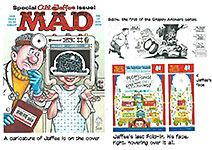
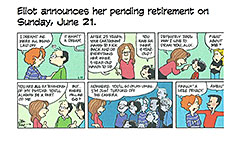
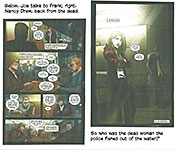
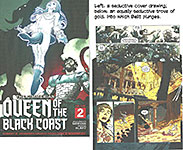

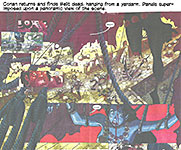
1.jpg)
2.jpg)
1.jpg)
2.jpg)
3.jpg)
4.jpg)

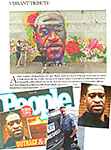
5.jpg)
6.jpg)
7.jpg)
8.jpg)
9.jpg)
10.jpg)
11.jpg)
12.jpg)
13.jpg)
1.jpg)
2.jpg)
3.jpg)
4.jpg)
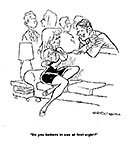
4.jpg)
